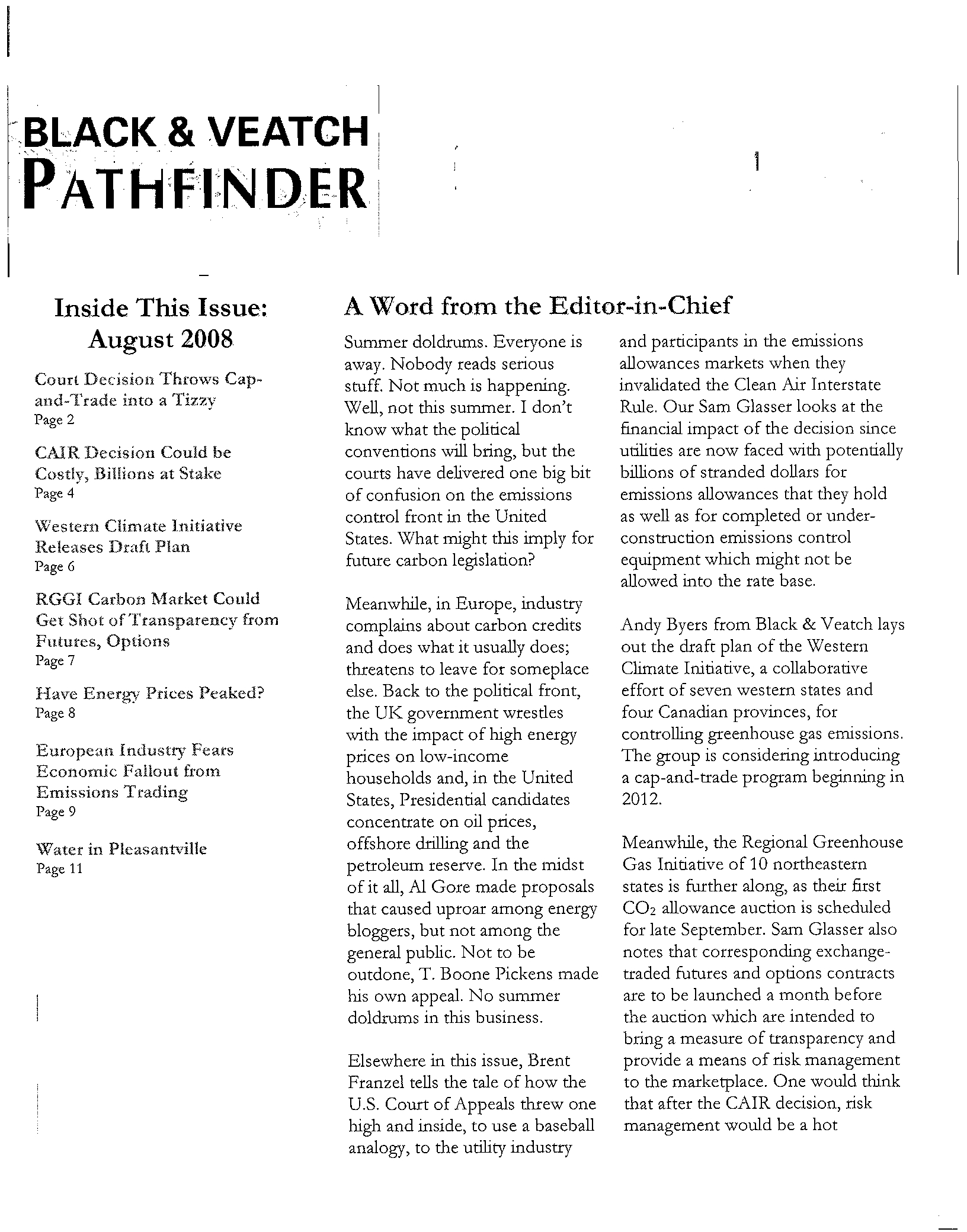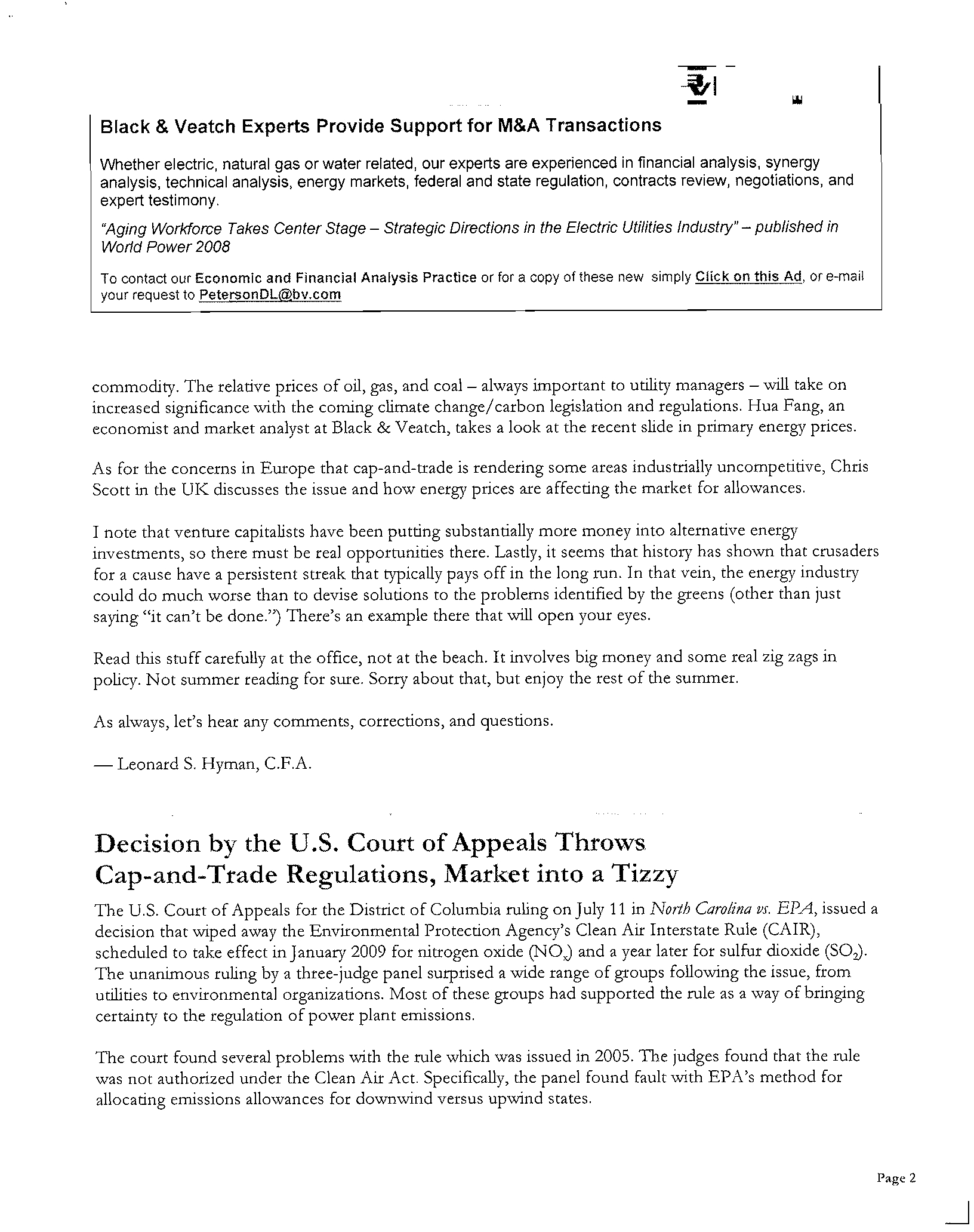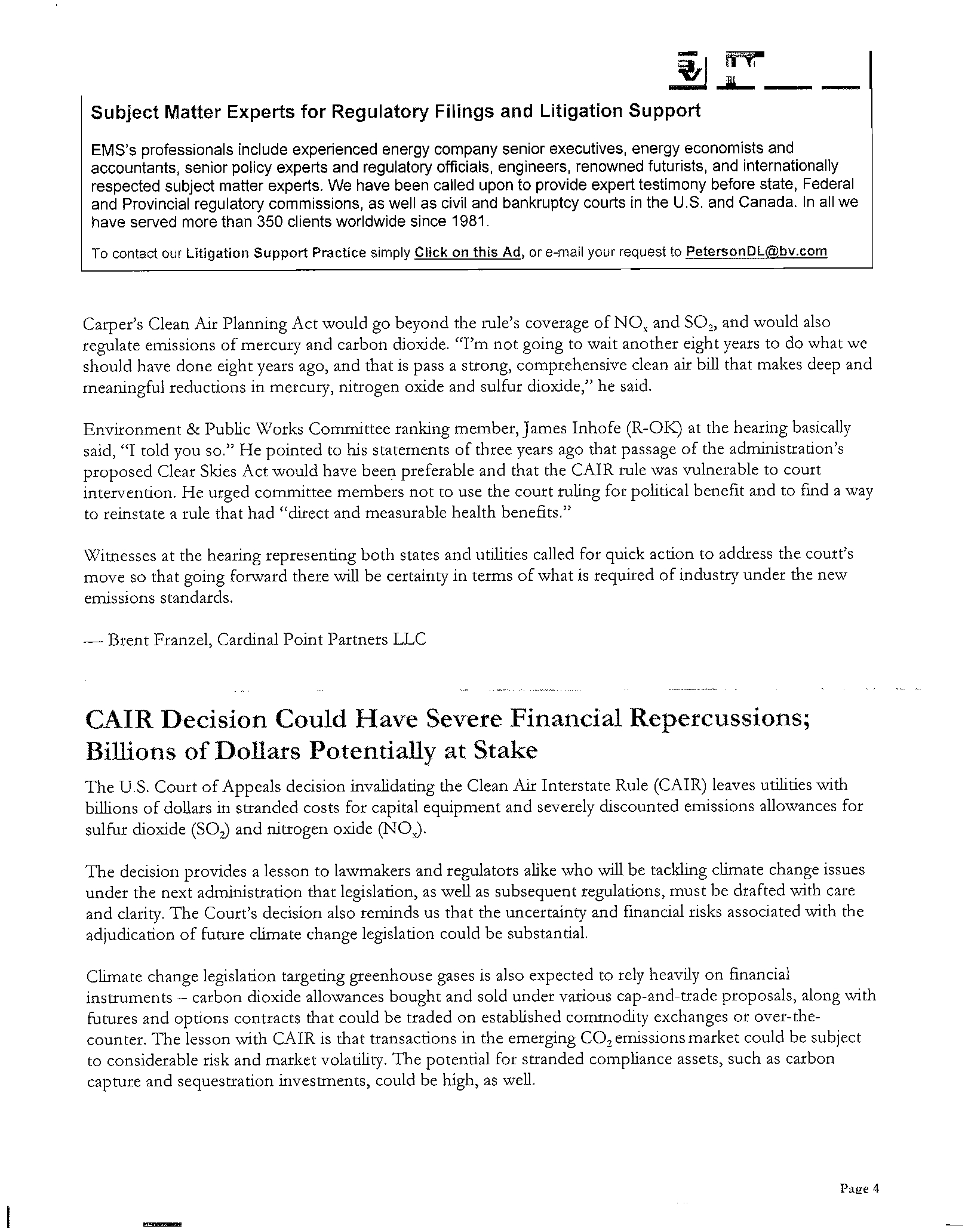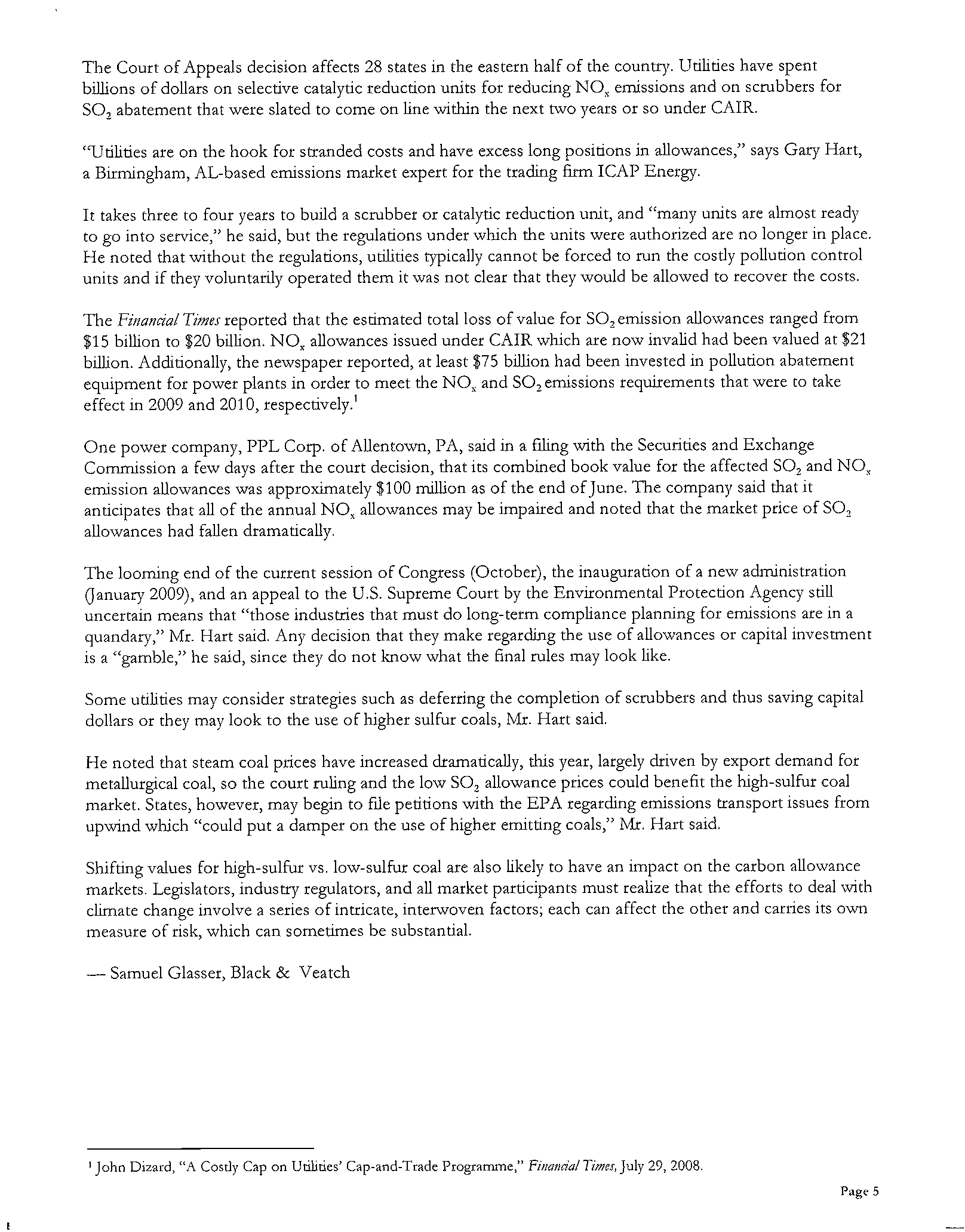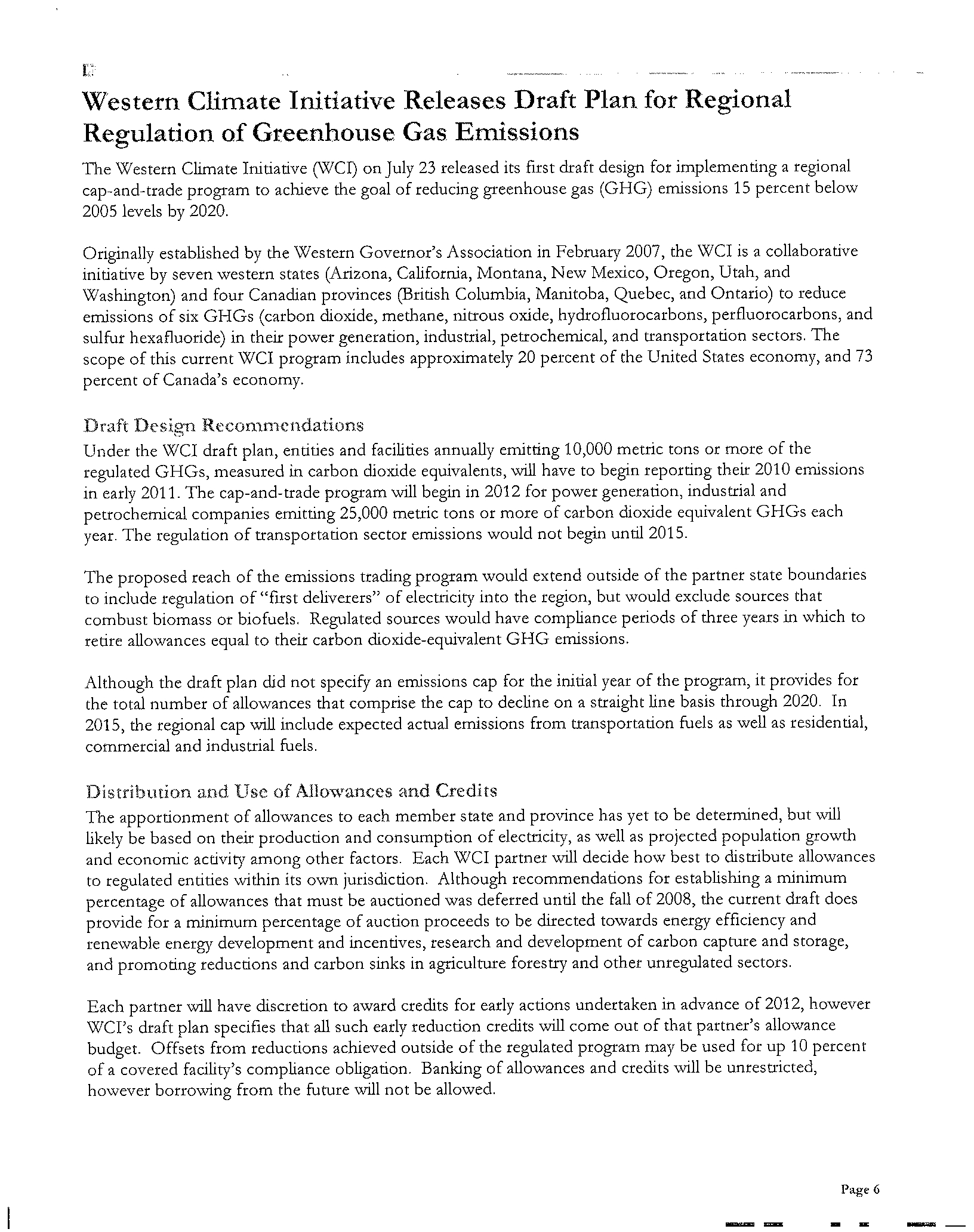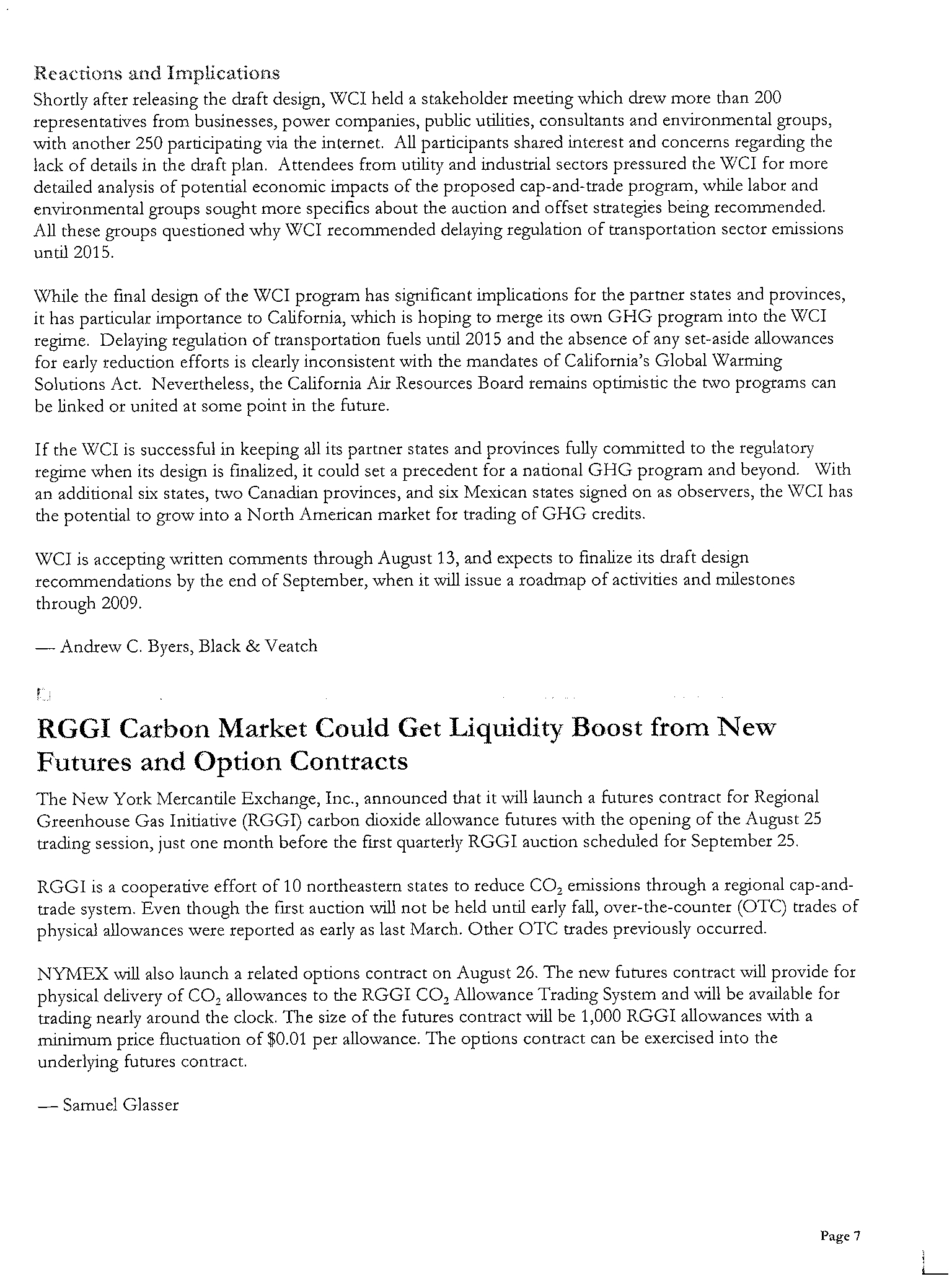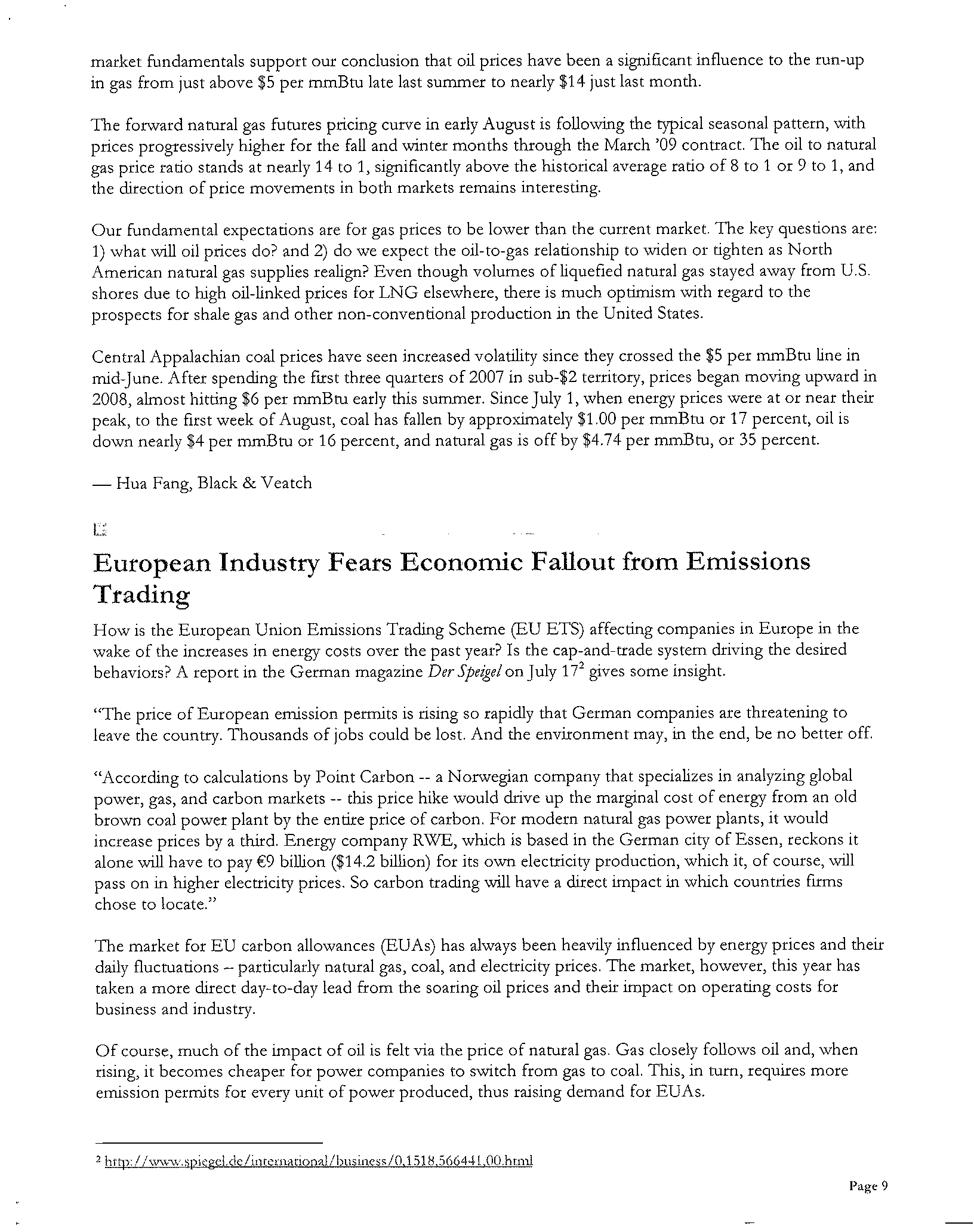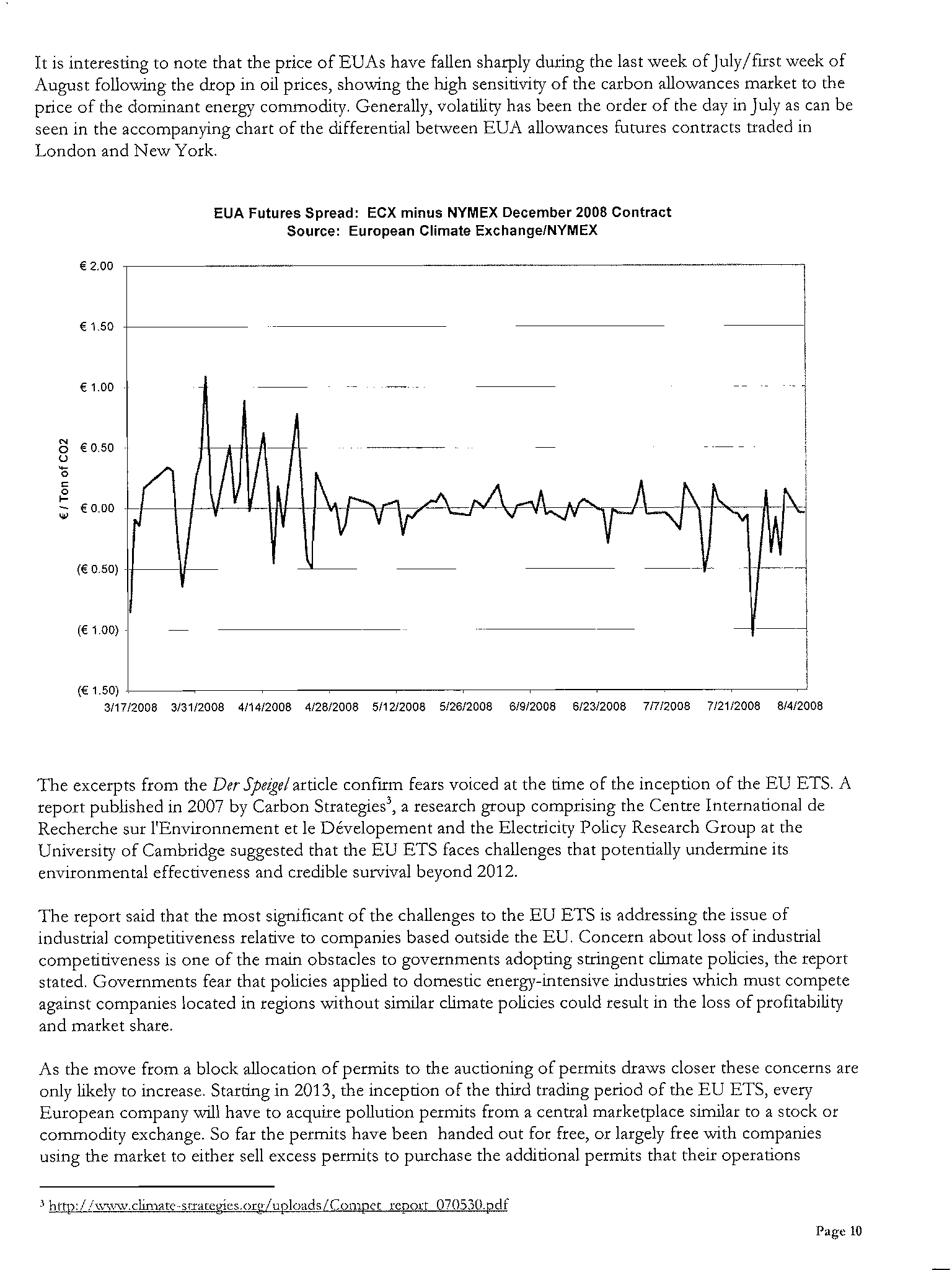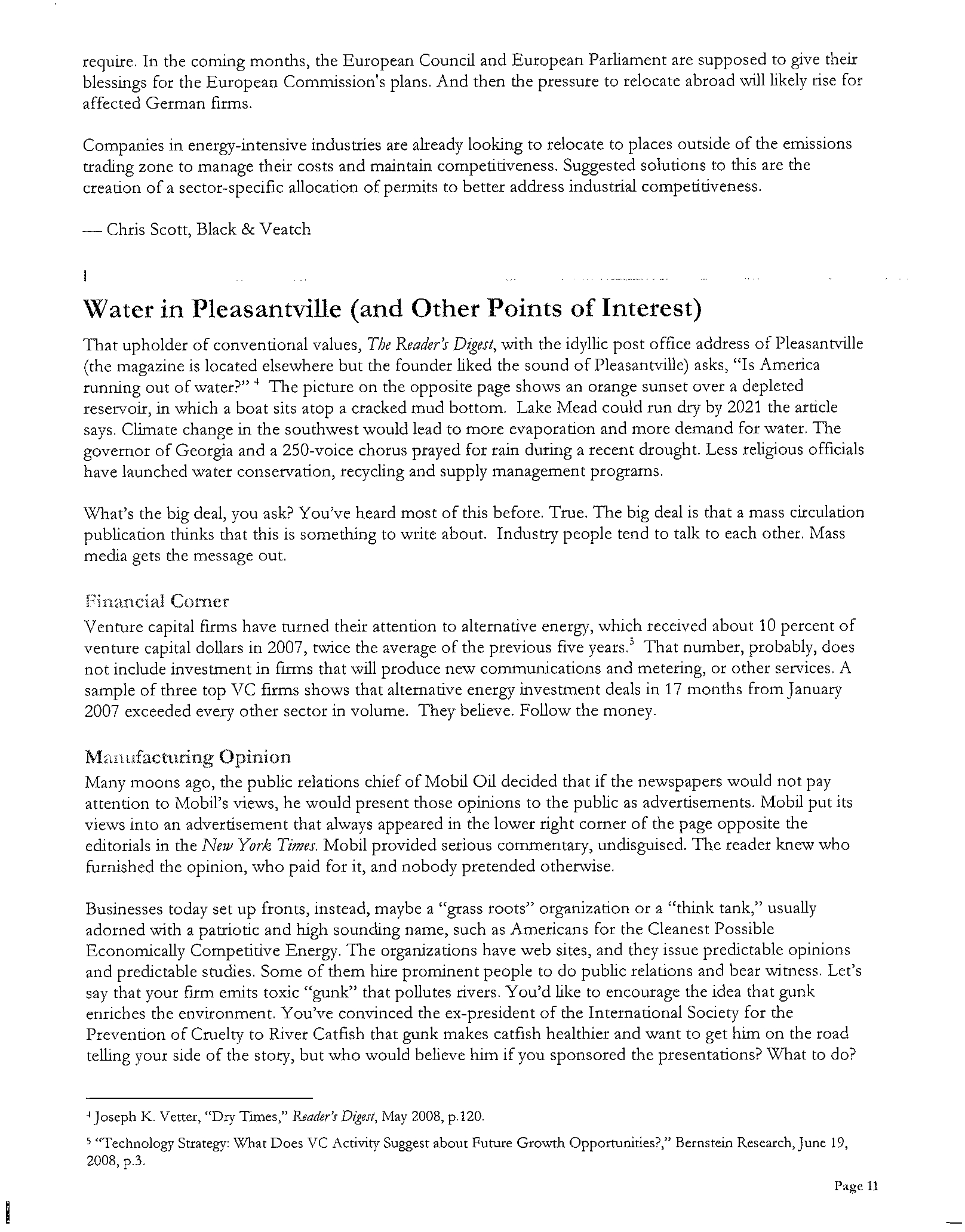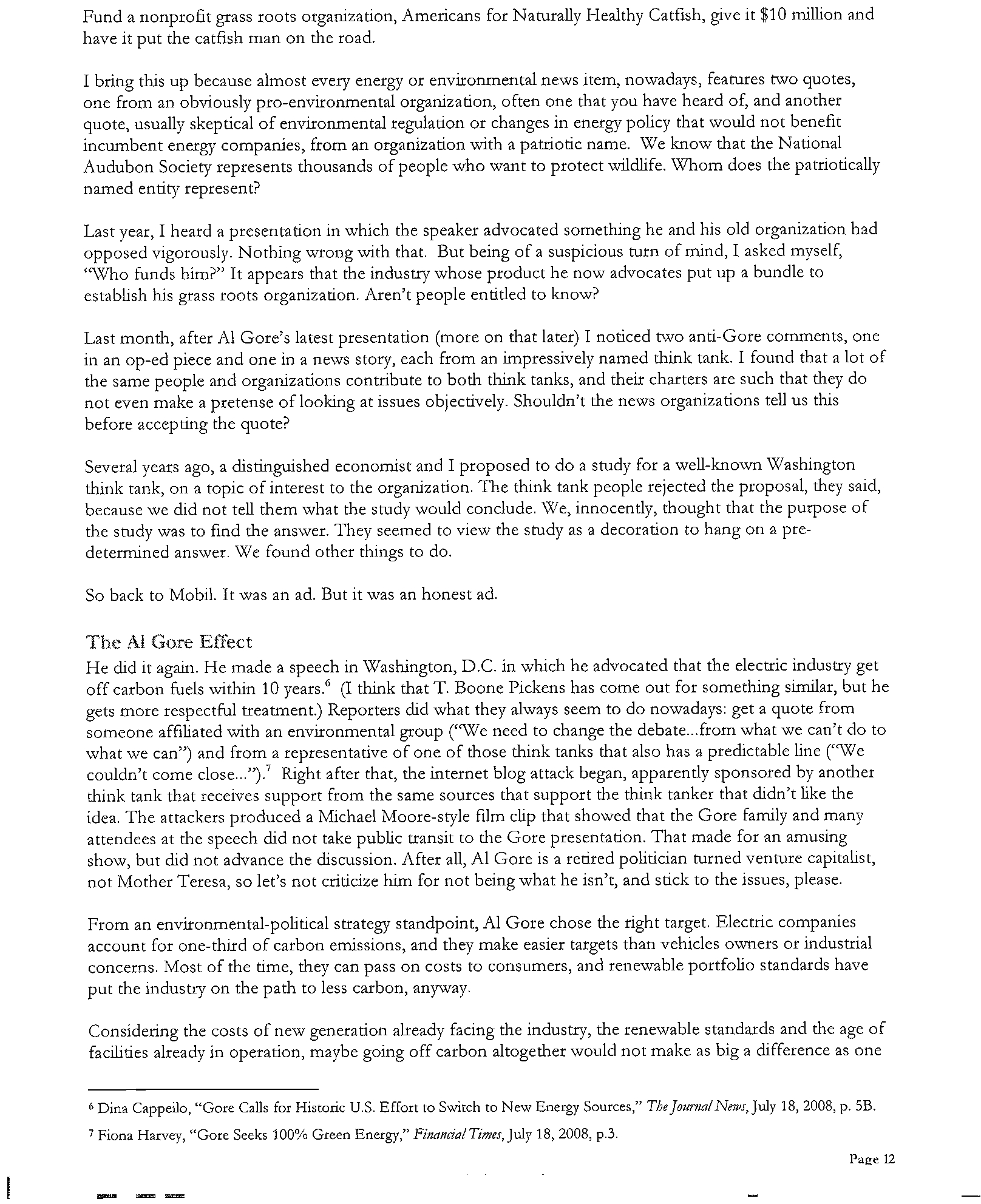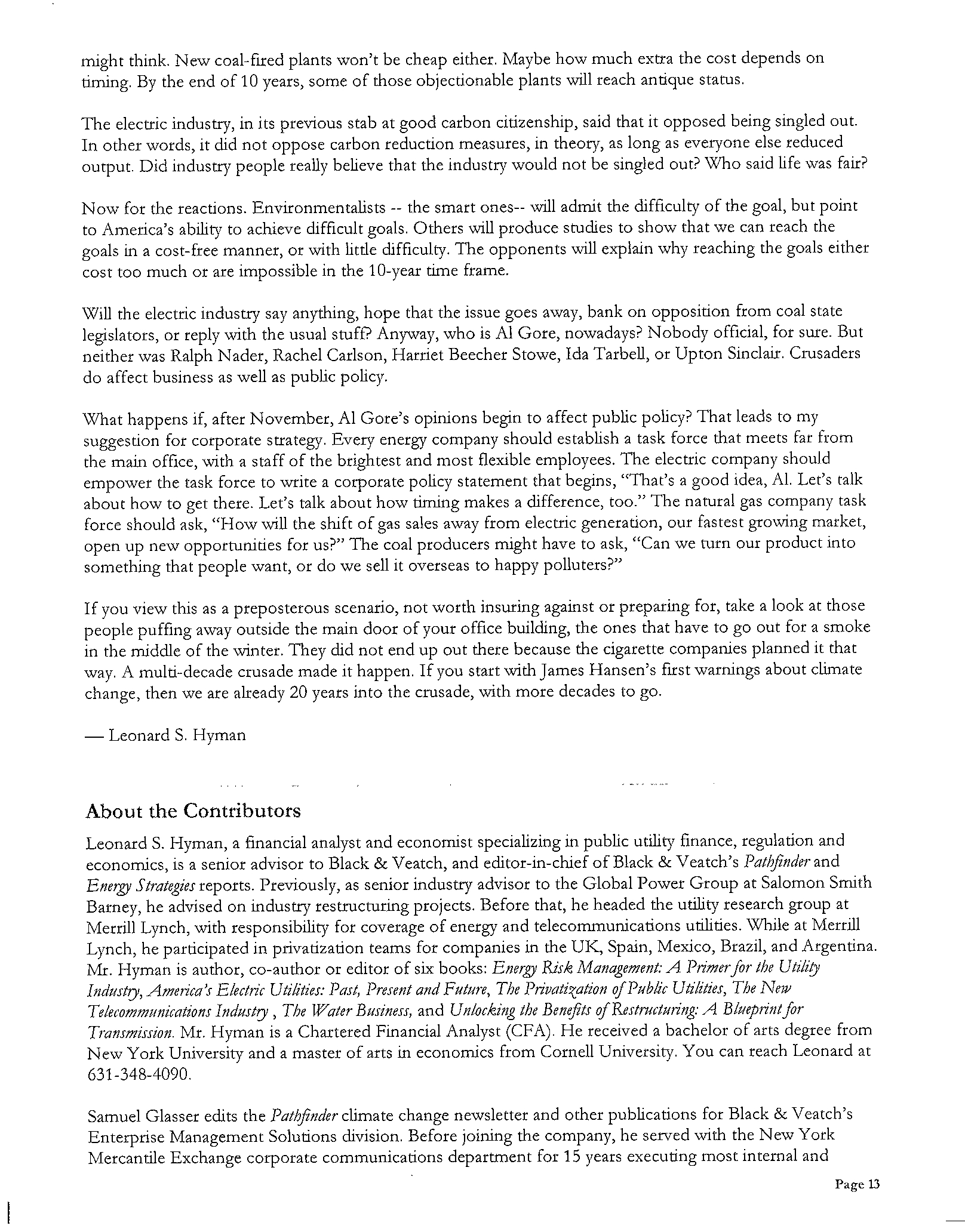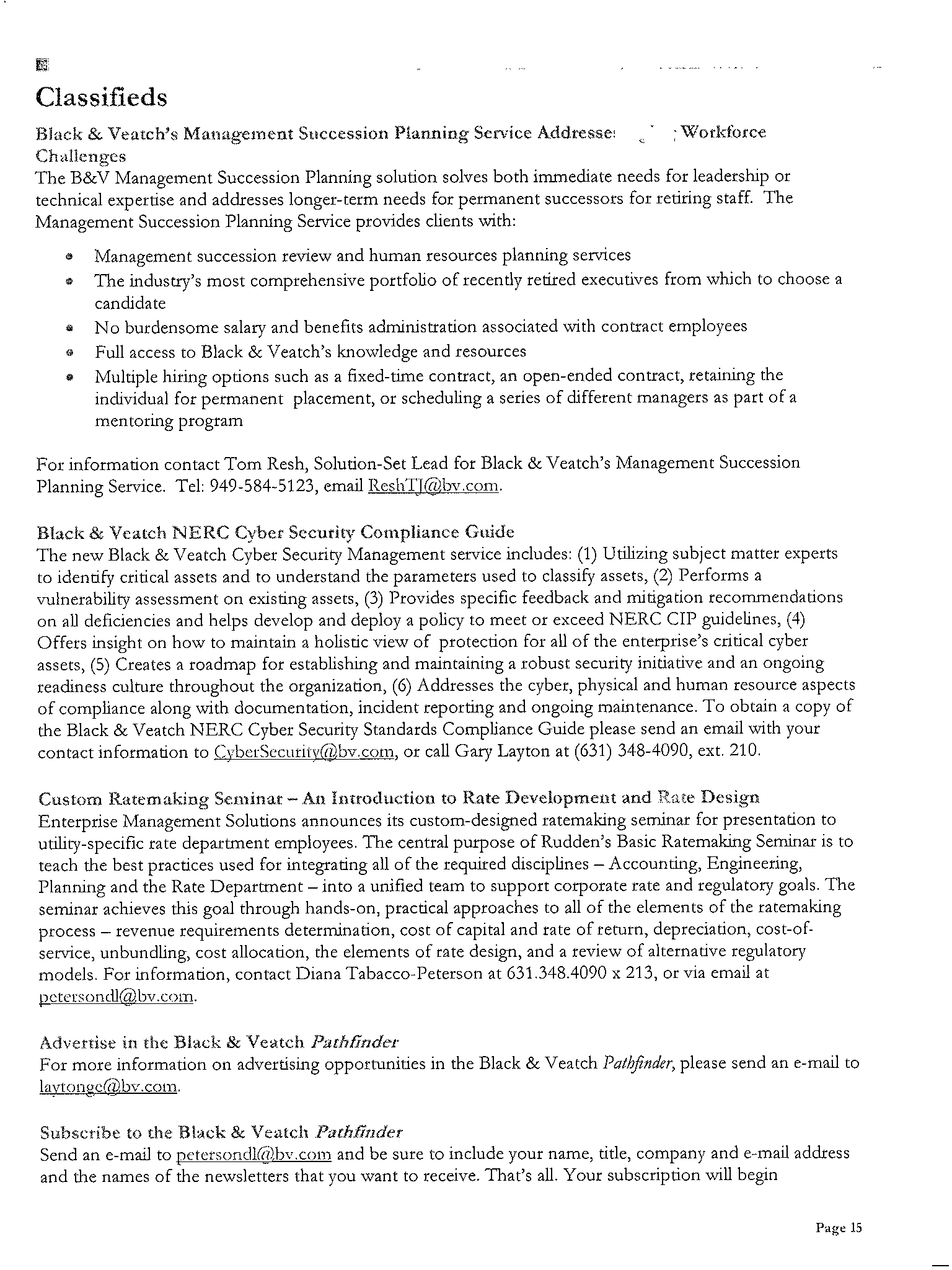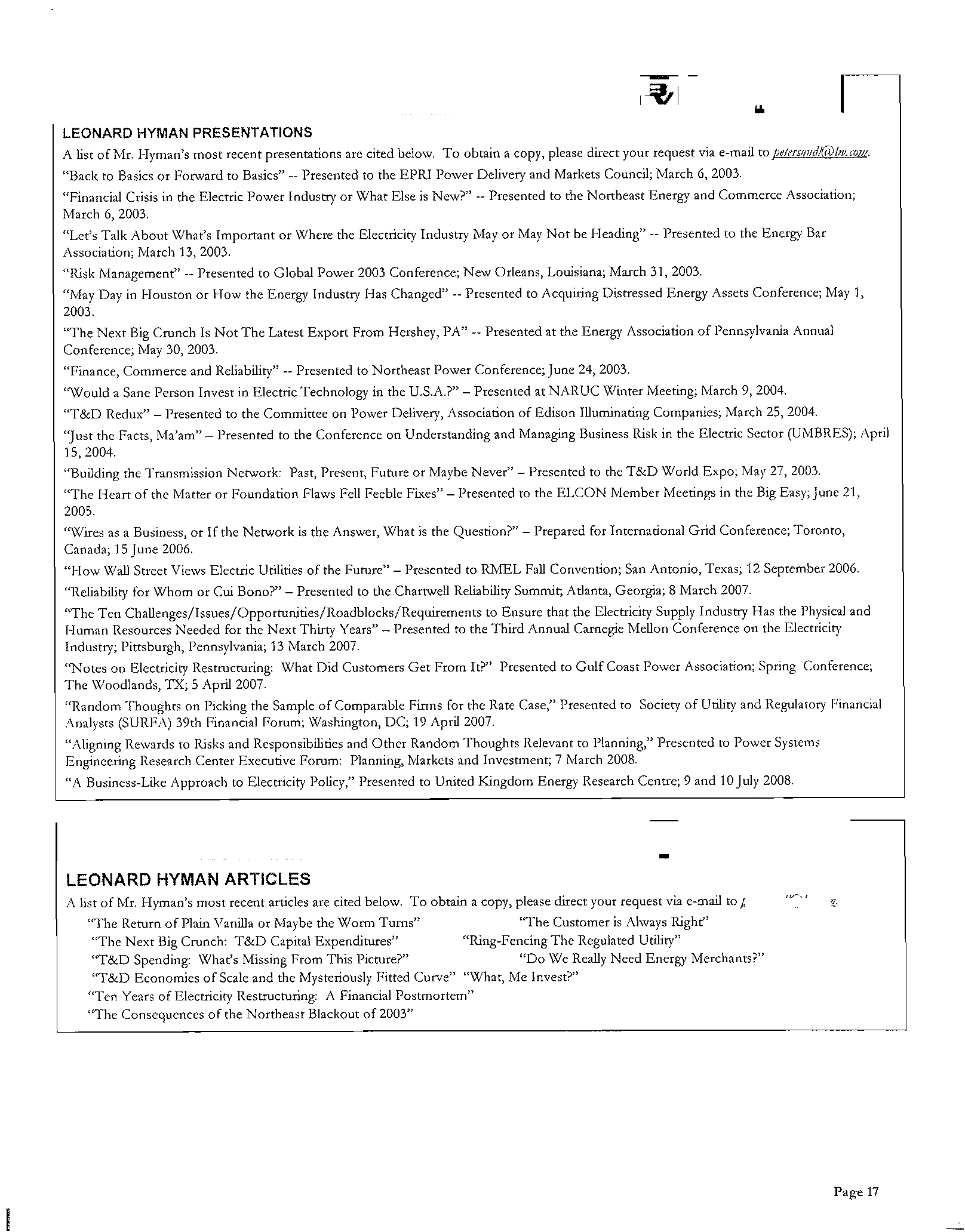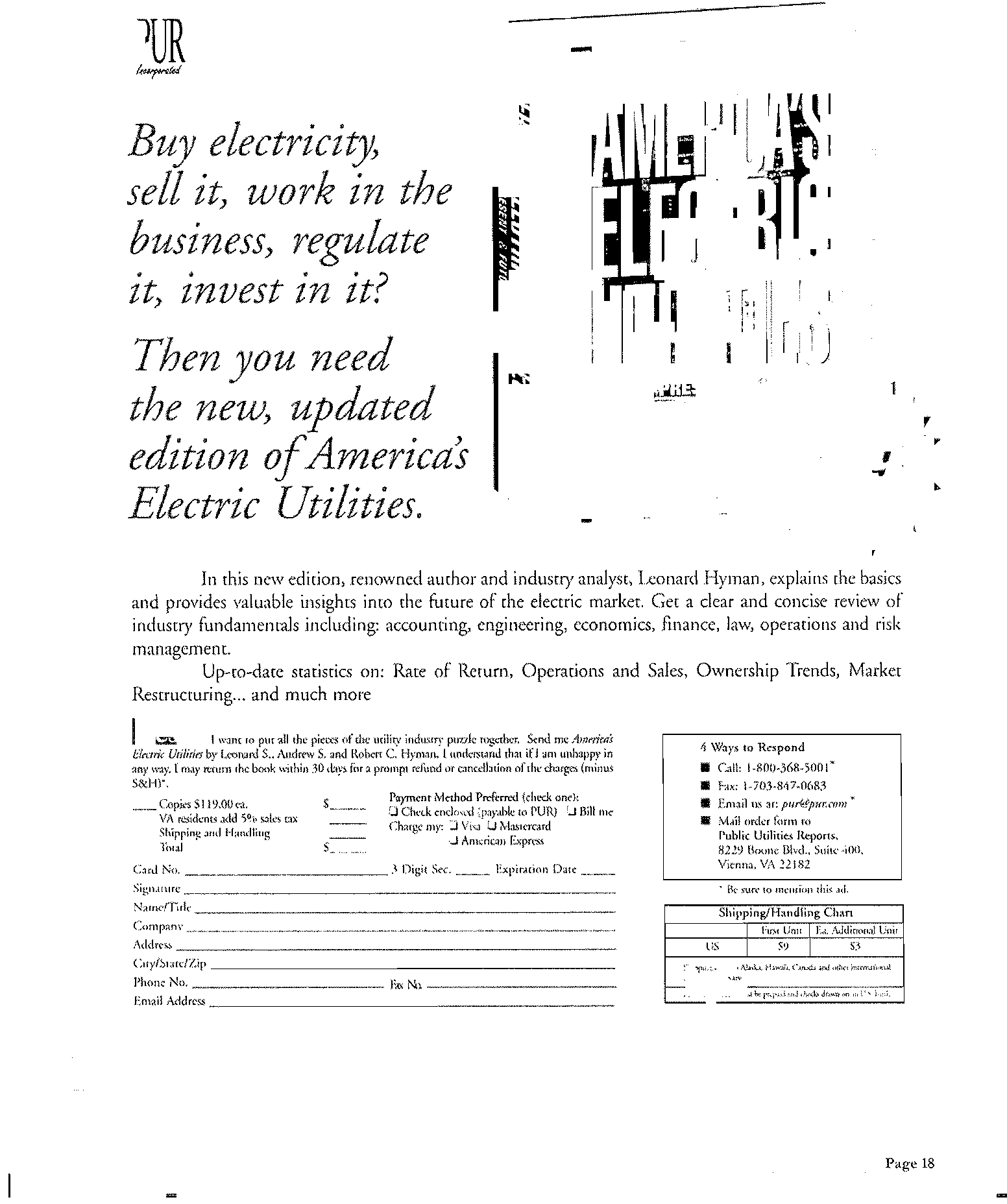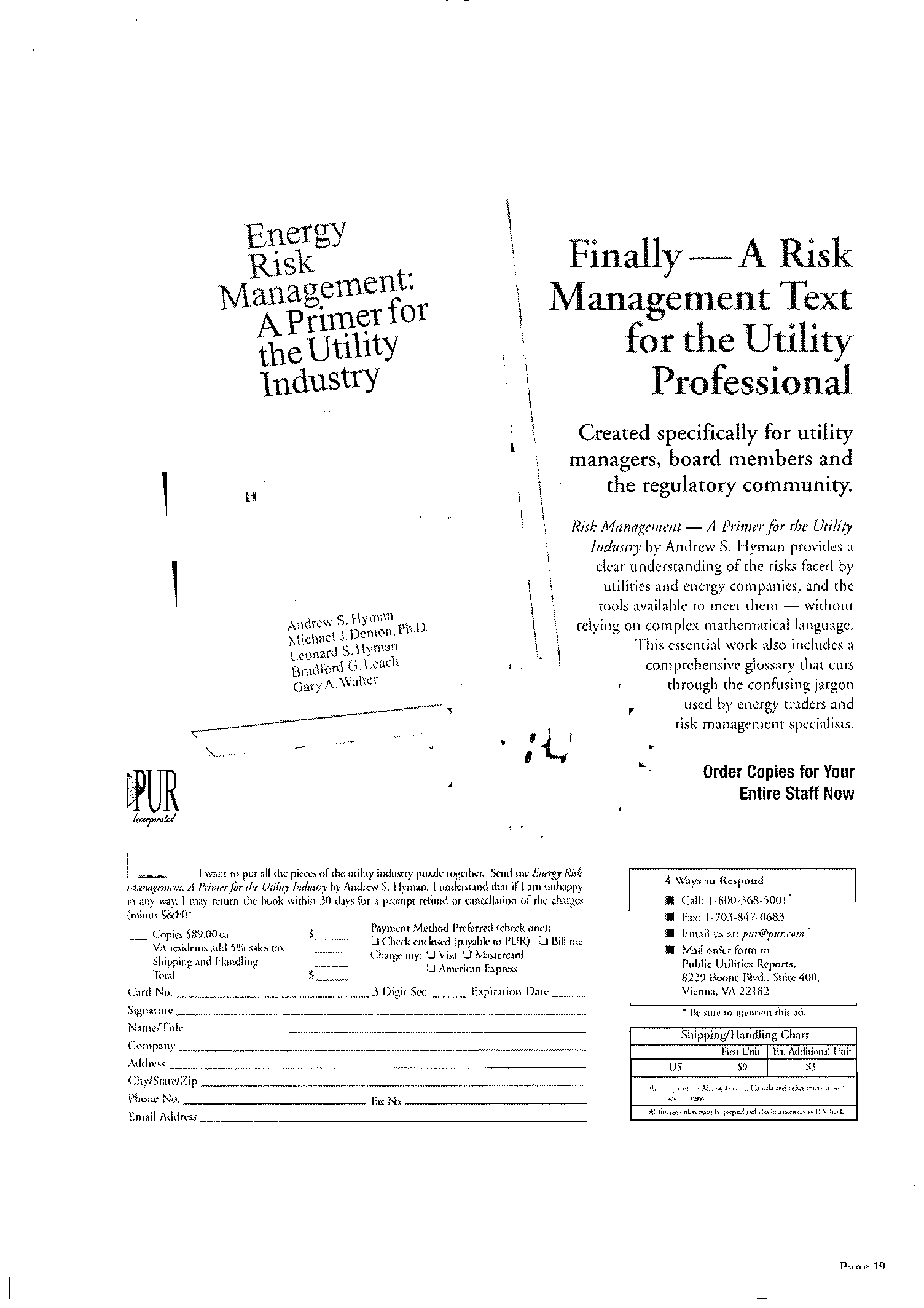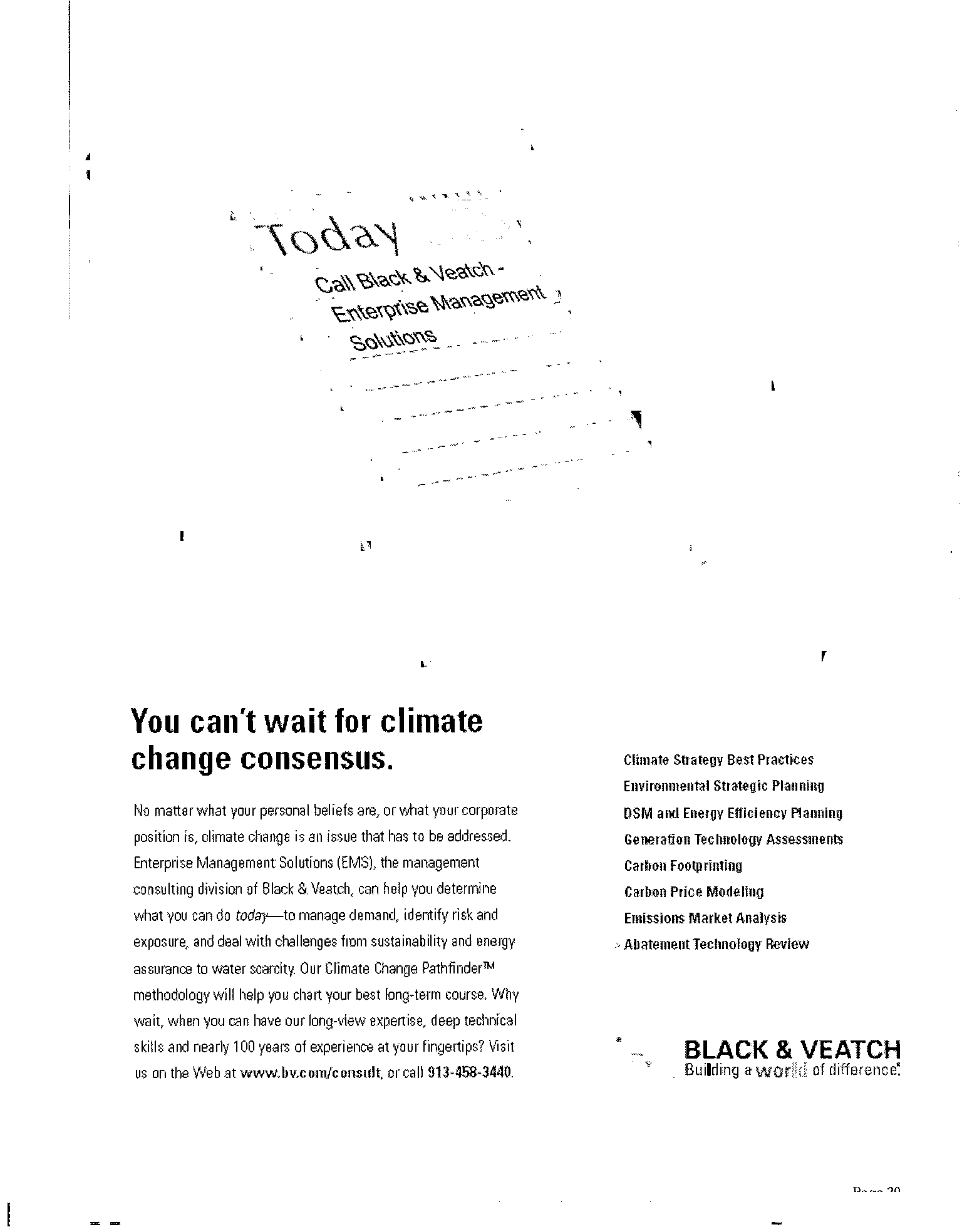Black
&-
Veatch
Pathfinder
(August
2008).
Electronic Filing - Received, Clerk's Office, October 1, 2008
* * * * * PCB 2009-021 * * * * *
A
Word
from
the
Editor-in-Chief
Inside
This
Back to top
Issue:
Back to top
August
2008
Court
Decision
Throws
Cap-
and-Trade
into
a
Tizzy
Page
2
CAIR
Decision
Could
be
Costly,
Billions
at
Stake
Page
4
Western
Climate
Initiative
Releases
Draft
Plan
Page
6
RGGI
Carbon
Market
Could
Get
Shot
of
Transparency
from
Futures,
Options
Page
7
Have
Energy
Prices
Peaked?
Page
8
European
Industry
Feats
Economic
Fallout
from
Emissions
Trading
Page
9
Watet
in
Pleasantville
Page
11
Summer
doldrums.
Everyone
is
away.
Nobody
reads
serious
stuff.
Not
much
is
happening.
Well,
not
this
summer.
I
don't
know
what
the
political
conventions
will
bring,
but
the
courts
have
delivered
one
big
bit
of
confusion
on
the
emissions
control
front
in
the
United
States.
What
might
this
imply
for
future
carbon
legislation?
Meanwhile,
in
Europe,
industry
complains
about
carbon
credits
and
does
what
it
usually
does;
threatens
to
leave
for
someplace
else.
Back
to
the
political
front,
the
UK
government
wrestles
with
the
impact
of
high
energy
prices
on
low-income
households
and,
in
the
United
States,
Presidential
candidates
concentrate
on
oil
prices,
offshore
drilling
and
the
petroleum
reserve.
In
the
midst
of
it
all,
AI
Gore
made
proposals
that
caused
uproar
among
energy
bloggers,
but
not
among
the
general
public.
Not
to
be
outdone,
T.
Boone
Pickens
made
his
own
appeal.
No
summer
doldrums
in
this
business.
Elsewhere
in
this
issue,
Brent
Franzel
tells
the
tale
of
how
the
U.S.
Court
of
Appeals
threw
one
high
and
inside,
to
use
a
baseball
analogy,
to
the
utility
industry
and
participants
in
the
emissions
allowances
markets
when
they
invalidated
the
Clean
Air
Interstate
Rule.
Our
Sam
Glasser
looks
at
the
financial
impact
of
the
decision
since
utilities
are
now
faced
with
potentially
billions
of
stranded
dollars
for
emissions
allowances
that
they
hold
as
well
as
for
completed
or
under-
construction
emissions
control
equipment
which
might
not
be
allowed
into
the
rate
base.
Andy
Byers
from
Black
&
Veatch
lays
out
the
draft
plan
of
the
Western
Climate
Initiative,
a
collaborative
effort
of
seven
western
states
and
four
Canadian
provinces,
for
controlling
greenhouse
gas
emissions.
The
group
is
considering
introducing
a
cap-and-trade
program
beginning
in
2012.
Meanwhile,
the
Regional
Greenhouse
Gas
Initiative
of
10
northeastern
states
is
further
along,
as
their
first
CO
2
allowance
auction
is
scheduled
for
late
September.
Sam
Glasser
also
notes
that
corresponding
exchange-
traded
furures
and
options
contracts
are
to
be
launched
a
month
before
the
auction
which
are
intended
to
bring
a
measure
of
transparency
and
provide
a
means
of
risk
management
to
the
marketplace.
One
would
think
that
after
the
CAIR
decision,
risk
management
would
be
a
hot
Electronic Filing - Received, Clerk's Office, October 1, 2008
* * * * * PCB 2009-021 * * * * *
World
Power
2008
To
contact
our
Economic
and
Financial
Analysis
Practice
or
for
a
copy
of
these
new
simply
Click
on
this
Ad,
or
e-mail
your
request
to
PetersonDL@bv.com
commodity.
The
relative
prices
of
oil,
gas,
and
coal
-
always
important
to
utility
managers
-
will
take
on
increased
significance
with
the
coming
climate
change/carbon
legislation
and
regulations.
Hua
Fang,
an
economist
and
market
analyst
at
Black
&
Veatch,
takes
a
look
at
the
recent
slide
in
primary
energy
prices.
As
for
the
concerns
in
Europe
that
cap-and-trade
is
rendering
some
areas
industrially
uncompetitive,
Chris
Scott
in
the
UK
discusses
the
issue
and
how
energy
prices
are
affecting
the
market
for
allowances.
I
note
that
venture
capitalists
have
been
putting
substantially
more
money
into
alternative
energy
investments,
so
there
must
be
real
opportunities
there.
Lastly,
it
seems
that
history
has
shown
that
crusaders
for
a
cause
have
a
persistent
streak
that
typically
pays
off
in
the
long
run.
In
that
vein,
the
energy
industry
could
do
much
worse
than
to
devise
solutions
to
the
problems
identified
by
the
greens
(other
than
just
saying
"it
can't
be
done.")
There's
an
example
there
that
will
open
your
eyes.
Read
this
stuff
carefully
at
the
office,
not
at
the
beach.
It
involves
big
money
and
some
real
zig
zags
in
policy.
Not
summer
reading
for
sure.
Sorry
about
that,
but
enjoy
the
rest
of
the
summer.
As
always,
let's
hear
any
comments,
corrections,
and
questions.
-
Leonard
S.
Hyman,
C.F.A
.
•
Decision
by
the
U.S.
Court
of
Back to top
Appeals
Back to top
Throws
Back to top
Cap-and-
Back to top
Trade
Back to top
Regulations,
Back to top
Market
into
a
Back to top
Tizzy
The
U.S.
Court
of
Appeals
for
the
District
of
Columbia
ruling
on
July
11
in
NOlth
Carol
ilia
vs.
EPA,
issued
a
decision
that
wiped
away
the
Environmental
Protection
Agency's
Clean
Air
Interstate
Rule
(CAIR),
scheduled
to
take
effect
in
January
2009
for
nitrogen
oxide
(NO,)
and
a
year
later
for
sulfur
dioxide
(SO,).
The
unanimous
ruling
by
a
three-judgepanel
surprised
a
wide
range
of
groups
following
the
issue,
from
utilities
to
environmental
organizations.
Most
of
these
groups
had
supported
the
rule
as
a
way
of
bringing
certainty
to
the
regulation
of
power
plant
emissions.
The
court
found
several
problems
with
the
rule
which
was
issued
in
2005.
The
judges
found
that
the
rule
was
not
authorized
under
the
Clean
Air
Act.
Specifically,
the
panel
found
fault
with
EPA's
method
for
allocating
emissions
allowances
for
downwind
versus
upwind
states.
Page
2
Electronic Filing - Received, Clerk's Office, October 1, 2008
* * * * * PCB 2009-021 * * * * *
To
contact
our
Rate
and
Regulatory
Support
Practice
or
to
obtain
copies
of
these
papers
simply
Click
on
this
Ad,
or
e.
mail
your
request
to
PetersonDL@bv.com
CAIR
covered
28
states
and
the
District
of
Columbia;
it
was
put
into
place
to
reduce
SO,
and
NO,
emissions
by
implementing
a
cap-and-trade
system
to
essentially
protect
downwind
states
on
the
East
Coast
from
power
plant
emissions
originating
in
rhe
Midwest.
The
state
of
North
Carolina
brought
suit
against
EPA,
arguing
that
rhe
rule
failed
to
provide
adequate
protections
to
downwind
states.
EPA
and
its
supporters
had
argued
that
the
rule
would
save
as
many
as
17,000
lives
per
year.
Even
though
CAIR
was
invalidated,
a
cap-and-trade
program
remains
in
force
that
allows
the
trading
of
SO,
allowances
under
the
Clean
Air
Act
amendments
of
1990
and
the
seasonal
NO,
trading
under
the
EPA
NO,
Budget
Trading
Program.
After
the
decision,
the
markets
for
the
affected
allowances
fell
out
of
bed.
The
nominal
price
of
SO,
allowance
futures
quoted
by
the
New
York
Mercantile
Exchange
fell
from
$300
per
ton
on
July
10
to
$130
on
July
11,
and
dipped
further
before
recovering
to
$132
per
ton
by
the
end
of
the
month.
The
nominal
price
for
the
2009
annual
NO,
allowance
futures
contract
dropped
from
$4,850
per
ton
on
July
10
to
$2,500
on
July
11,
and
to
$1,000
by
July
31.
EPA
officials
have
until
rhe
end
of
August
to
decide
wherher
to
appeal
the
Court
of
Appeals
ruling
or
attempt
to
modify
the
rule
to
comply
with
the
court's
objections.
In
the
alternative,
Congress
can
pass
new
legislation
to
address
the
problem
-
either
specifically
aimed
at
rhe
CAIR
rule
or
as
a
modification
to
the
Clean
Ail:
Act.
That
is
almost
certain
not
to
happen
during
the
current
session
which
is
scheduled
to
end
in
early
October.
Additionally,
Congress
adjourned
on
August
1,
not
to
return
to
the
Capitol
until
after
Labor
Day.
In
a
related
development
on
the
same
day
as
the
court
decision,
the
Bush
Administration's
release
of
a
proposed
rule
making
would
also
seem
to
indicate
that
any
action
under
the
Clean
Air
Act
is
unlikely
until
the
new
president
takes
over.
The
EPA
asked
for
public
COmment
on
a
proposed
rulemaking
in
which
it
stated
the
Clean
AU:
Act
is
not
the
appropriate
vehicle
for
regulating
greenhouse
gas
emissions.
The
proposed
rule
was
issued
in
response
to
the
Supreme
Court's
Massachusetts
v.
EPA
decision
in
which
the
court
ruled
that
the
regulation
of
greenhouse
gases
from
motor
vehicles
falls
under
the
aurhority
of
rhe
EPA
via
rhe
Clean
Ail:
Act.
The
Bush
Administration
disputes
rhar
position
and
White
House
officials
argued
rhat
using
rhe
law
to
regulate
greenhouse
gas
emissions
would
harm
rhe
U.S.
economy.
Envil:onmenral
groups
and
Democrats
in
Congress
were
severely
critical
of
rhe
President
and
EPA
Administrator
Srephen
Johnson
following
the
announcement,
which
was
a
reversal
of
conclusions
in
a
draft
EPA
study
completed
last
year.
Regardless
of
what
the
Bush
Administration
decides
to
do
on
this
issue,
Congress
and
the
next
president
will
be
forced
to
address
it.
At
a
July
29
Senate
hearing,
members
on
both
sides
of
the
aisle
called
for
action
to
reinstate
the
goals
of
the
CAIR
rule.
Clean
Ail:
&
Nuclear
Safety
Subcommittee
Chairman
Tom
Carper
(D-DE)
pushed
for
passage
of
a
bill
he
has
introduced
to
provide
even
wider
coverage
of
emissions.
Sen.
Page
3
Electronic Filing - Received, Clerk's Office, October 1, 2008
* * * * * PCB 2009-021 * * * * *
To
contact
our
Litigation
Support
Practice
simply
Click
on
this
Ad,
or
e-mail
yourrequesttoPetersonDL@bv.com
Carper's
Clean
Air
Planning
Act
would
go
beyond
the
rule's
coverage
of
NO,
and
SO"
and
would
also
regulate
emissions
of
mercury
and
carbon
dioxide.
''I'm
not
going
to
wait
another
eight
years
to
do
what
we
should
have
done
eight
years
ago,
and
that
is
pass
a
strong,
comprehensive
clean
air
bill
that
makes
deep
and
meaningful
reductions
in
mercury,
nitrogen
oxide
and
sulfur
dioxide,"
he
said.
Environment
&
Public
Works
Committee
ranking
member,
James
Inhofe
(R-OK)
at
the
hearing
basically
said,
"I
told
you
so."
He
pointed
to
his
statements
of
three
years
ago
that
passage
of
the
administration's
proposed
Clear
Skies
Act
would
have
been
preferable
and
that
the
CAIR
rule
was
vulnerable
to
court
intervention.
He
urged
committee
members
not
to
use
the
court
ruling
for
political
benefit
and
to
find
a
way
to
reinstate
a
rule
that
had
"direct
and
measurable
health
benefits."
Witnesses
at
the
hearing
representing
both
states
and
utilities
called
for
quick
action
to
address
the
court's
move
so
that
going
forward
there
will
be
certainty
in
terms
of
what
is
required
of
industry
under
the
new
emissions
standards.
-
Brent
Franzel,
Cardinal
Point
Partners
LLC
--
-
--
CAIR
Decision
Back to top
Could
Have
Back to top
Severe
Back to top
Financial
Back to top
Repercussions;
Back to top
Billions
of
Back to top
Dollars
Back to top
Potentially
at
Back to top
Stake
The
u.s.
Court
of
Appeals
decision
invalidating
the
Clean
Air
Interstate
Rule
(CAIR)
leaves
utilities
with
billions
of
dollars
in
stranded
costs
for
capital
equipment
and
severely
discounted
emissions
allowances
for
sulfur
dioxide
(SO,)
and
nitrogen
oxide
(NO,,).
The
decision
provides
a
lesson
to
lawmakers
and
regulators
alike
who
will
be
tackling
climate
change
issues
under
the
next
administration
that
legislation,
as
well
as
subsequent
regulations,
must
be
drafted
with
care
and
clarity.
The
Court's
decision
also
reminds
us
that
the
uncertainty
and
financial
risks
associated
with
the
adjudication
of
future
climate
change
legislation
could
be
substantial.
Climate
change
legislation
targeting
greenhouse
gases
is
also
expected
to
rely
heavily
on
fmancial
instruments
-
carbon
dioxide
allowances
bought
and
sold
under
various
cap-and-trade
proposals,
along
with
furures
and
options
contracts
that
could
be
traded
on
established
commodity
exchanges
or
over-the-
counter.
The
lesson
with
CAIR
is
that
transactions
in
the
emerging
CO,
emissions
market
could
be
subject
to
considerable
risk
and
market
volatility_
The
potential
for
stranded
compliance
assets,
such
as
carbon
capture
and
sequestration
investments,
could
be
high,
as
well.
P;,t.gc
4
Electronic Filing - Received, Clerk's Office, October 1, 2008
* * * * * PCB 2009-021 * * * * *
He
noted
that
without
the
regulations,
utilities
typically
cannot
be
forced
to
run
the
costly
pollution
control
units
and
if
they
voluntarily
operatedthem
it
was
not
clear
that
they
would
be
allowed
to
recover
the
costs.
The
Financial
Times
reported
that
the
estimated
total
loss
of
value
for
50
2
emission
allowances
ranged
from
15
billion
to
20
billion.
NO,
allowances
issued
under
CAIR
which
are
now
invalid
had
been
valued
at
21
billion.
Additionally,
the
newspaper
reported,
at
least
75
billion
had
been
invested
in
pollution
abatement
equipment
for
power
plants
in
order
to
meet
the
NO,
and
50
2
emissions
requirements
that
were
to
take
effect
in
2009
and
2010,
respectively.'
One
power
company,
PPL
Corp.
of
Allentown,
PA,
said
in
a
filing
with
the
Securities
and
Exchange
Commission
a
few
days
after
the
court
decision,
that
its
combined
book
value
for
the
affected
50
2
and
NO,
emission
allowances
was
approximately
100
million
as
of
the
end
of
June.
The
company
said
that
it
anticipates
that
all
of
the
annual
NO,
allowances
may
be
impaired
and
noted
that
the
market
price
of
50
2
allowances
had
fallen
dramatically.
The
looming
end
of
the
current
session
of
Congress
(October),
the
inauguration
of
a
new
administration
Oanuary
2009),
and
an
appeal
to
the
U.S.
Supreme
Court
by
the
Environmental
Protection
Agency
still
uncertain
means
that
"those
industries
that
must
do
long-term
compliance
planning
for
emissions
arc
in
a
quandary,"
Mr.
Hart
said.
Any
decision
that
they
make
regarding
the
use
of
allowances
or
capital
investment
is
a
"gamble,"
he
said,
since
they
do
not
know
what
the
final
rules
may
look
like.
Some
utilities
may
consider
strategies
such
as
deferring
the
completion
of
scrubbers
and
thus
saving
capital
dollars
or
they
may
look
to
the
use
of
higher
sulfur
coals,
Mr.
Hart
said.
He
noted
that
steam
coal
prices
have
increased
dramatically,
this
year,
largely
driven
by
export
demand
for
metallurgical
coal,
so
the
court
ruling
and
the
low
50
2
allowance
prices
could
benefit
the
high-sulfur
coal
market.
States,
however,
may
begin
to
me
petitions
with
the
EPA
regarding
emissions
transport
issues
from
upwind
which
"could
put
a
damper
on
the
use
of
higher
emitting
coals,"
Mr.
Hart
said.
Shifting
values
for
high-sulfur
vs.
low-sulfur
coal
are
also
likely
to
have
an
impact
on
the
carbon
allowance
markets.
Legislators,
industry
regulators,
and
all
market
participants
must
realize
that
the
efforts
to
deal
with
climate
change
involve
a
series
of
intricate,
interwoven
factors;
each
can
affect
the
other
and
carries
its
own
measure
of
risk,
which
can
sometimes
be
substantial.
-
Samuel
Glasser,
Black
&
Veatch
1
John
Dizard,
"A
Costly
Cap
on
Utilities'
Cap-and-Trade
Programme,"
Fifloflcio/Time.I,]uly
29,
2008.
Page
5
Electronic Filing - Received, Clerk's Office, October 1, 2008
* * * * * PCB 2009-021 * * * * *
Originally
established
by
the
Western
Governor's
Association
in
February
2007,
the
WCI
is
a
collaborative
initiative
by
seven
western
states
(Arizona,
California,
Montana,
New
Mexico,
Oregon,
Utah,
and
Washington)
and
four
Canadian
provinces
(British
Columbia,
Manitoba,
Quebec,
and
Ontario)
to
reduce
emissions
of
six
GHGs
(carbon
dioxide,
methane,
nitrous
oxide,
hydro
fluorocarbons,
perfluorocarbons,
and
sulfur
hexafluoride)
in
their
power
generation,
industrial,
petrochemical,
and
transportation
sectors.
The
scope
of
this
current
WCI
program
includes
approximately
20
percent
of
the
United
States
economy,
and
73
percent
of
Canada's
economy.
Draft
Design
Recommendations
Under
the
WCI
draft
plan,
entities
and
facilities
annually
emitting
10,000
metric
tons
or
more
of
the
regulated
GHGs,
measured
in
carbon
dioxide
equivalents,
,vill
have
to
begin
reporting
their
2010
emissions
in
early
2011.
The
cap-and-trade
program
will
begin
in
2012
for
power
generation,
industrial
and
petrochemical
companies
emitting
25,000
metric
tons
or
more
of
carbon
dioxide
equivalent
GHGs
each
year.
The
regulation
of
transportation
sector
emissions
would
not
begin
until
2015.
The
proposed
reach
of
the
emissions
trading
program
would
extend
outside
of
the
partner
state
boundaries
to
include
regulation
of
"fIrst
deliverers"
of
electricity
into
the
region,
but
would
exclude
sources
that
combust
biomass
or
biofuels.
Regulated
sources
would
have
compliance
periods
of
three
years
in
which
to
retire
allowances
equal
to
their
carbon
dioxide-equivalent
GHG
emissions.
Although
the
draft
plan
did
not
specify
an
emissions
cap
for
the
initial
year
of
the
program,
it
provides
for
the
total
number
of
allowances
that
comprise
the
cap
to
decline
on
a
straight
line
basis
through
2020.
In
2015,
the
regional
cap
will
include
expected
actual
emissions
from
transportation
fuels
as
well
as
residential,
commercial
and
industrial
fuels.
Distribution
and
Use
of
Allowances
and
Credits
The
apportionment
of
allowances
to
each
member
state
and
province
has
yet
to
be
determined,
but
\vill
likely
be
based
on
their
production
and
consumption
of
electricity,
as
well
as
projected
population
growth
and
economic
activity
among
other
factors.
Each
WCI
partner
will
decide
how
best
to
distribute
allowances
to
regulated
entities
within
its
own
jurisdiction.
Although
recommendations
for
establishing
a
minimum
percentage
of
allowances
that
must
be
auctioned
was
deferred
until
the
fall
of
2008,
the
current
draft
does
provide
for
a
minimum
percentage
of
auction
proceeds
to
be
directed
towards
energy
effIciency
and
renewable
energy
development
and
incentives,
research
and
development
of
carbon
capture
and
storage,
and
promoting
reductions
and
carbon
sinksin
agriculture
forestry
and
other
unregulated
sectors.
Each
partner
will
have
discretion
to
award
credits
for
early
actions
undertaken
in
advance
of
2012,
however
WCI's
draft
plan
specifIes
that
all
such
early
reduction
credits
will
come
out
of
that
partner's
allowance
budget.
Offsets
from
reductions
achieved
outside
of
the
regulated
program
may
be
used
for
up
10
percent
of
a
covered
facility's
compliance
obligation.
Banking
of
allowances
and
credits
will
be
unrestricted,
however
borrowing
from
the
future
will
not
be
allowed.
Page
6
Electronic Filing - Received, Clerk's Office, October 1, 2008
* * * * * PCB 2009-021 * * * * *
While
the
final
design
of
the
WCI
program
has
significant
implications
for
the
partner
states
and
provinces,
it
has
particular
importance
to
California,
which
is
hoping
to
merge
its
own
GHG
program
into
the
WCI
regime.
Delaying
regulation
of
transportation
fuels
until
2015
and
the
absence
of
any
set-aside
allowances
for
early
reduction
efforts
is
clearly
inconsistent
with
the
mandates
of
California's
Global
Warming
Solutions
Act.
Nevertheless,
the
California
Air
Resources
Board
remains
optimistic
the
two
programs
can
be
linked
or
united
at
some
point
in
the
future.
If
the
WCI
is
successful
in
keeping
all
its
partner
states
and
provinces
fully
committed
to
the
regulatory
regime
when
its
design
is
fmafued,
it
could
set
a
precedent
for
a
national
GHG
program
and
beyond.
With
an
additional
six
states,
two
Canadian
provinces,
and
six
Mexican
states
signed
on
as
observers,
the
\x/CI
has
the
potential
to
grow
into
a
North
American
market
for
trading
of
GHG
credits.
WCI
is
accepting
written
comments
through
August
13,
and
expects
to
finalize
its
draft
design
recommendations
by
the
end
of
September,
when
it
will
issue
a
roadmap
of
activities
and
milestones
through
2009.
-
Andrew
C.
Byers,
Black
&
Veatch
RGGI
Carbon
Back to top
Market
Back to top
Could
Get
Back to top
Liquidity
Back to top
Boost
from
New
Back to top
Futures
and
Back to top
Option
Back to top
Contracts
The
New
York
Mercantile
Exchange,
Inc.,
announced
that
it
will
launch
a
futures
contract
for
Regional
Greenhouse
Gas
Initiative
(RGGI)
carbon
dioxide
allowance
futures
with
the
opening
of
the
August
25
trading
session,
just
one
month
before
the
first
quarterly
RGGI
auction
scheduled
for
September
25.
RGGI
is
a
cooperative
effort
of
10
northeastern
states
to
reduce
CO,
emissions
through
a
regional
cap-and-
trade
system.
Even
though
the
first
auction
will
not
be
held
until
early
fall,
over-the-counter
(OTC)
trades
of
physical
allowances
were
reported
as
early
as
last
March.
Other
OTe
trades
previously
occurred.
NYMEX
will
also
launch
a
related
options
contract
on
August
26.
The
new
futures
contract
will
provide
for
physical
delivery
of
CO,
allowances
to
the
RGGI
CO,
Allowance
Trading
System
and
will
be
available
for
trading
nearly
around
the
clock.
The
size
of
the
futures
contract
will
be
1,000
RGGI
allowances
with
a
minimum
price
fluctuation
of
.
0.01
per
allowance.
The
options
contract
can
be
exercised
into
the
underlying
futures
contract.
-
Samuel
Glasser
Page
7
Electronic Filing - Received, Clerk's Office, October 1, 2008
* * * * * PCB 2009-021 * * * * *
The
relative
long-term
prices
of
primary
energy
-
oil,
natural
gas,
and
coal
-
coupled
with
the
severity
and
cost
of
new
climate
change
legislation,
will
be
of
the
utmost
importance
to
utility
planners
who
will
need
to
decide
how
to
fuel
new
generating
capacity.
If
gas
prices
go
too
high,
coal
becomes
the
fuel
of
choice
even
with
carbon
legislation.
In
tum,
increased
coal
use
increases
the
demand
for
CO
2
allowances,
driving
allowance
prices
up.
If
the
potential
carbon
rules
are
too
onerous
or
the
government
fails
to
send
clear
signals
on
where
the
rules
are
headed,
gas
will
likely
be
chosen
as
at
least
an
interim
solution
in
order
to
keep
the
lights
on.
West
Texas
Intermediate
Crude
Oil,
Natural
Gas,
Coal
Spot
Month
Futures
Prices
Source:
New
York
Mercantile
Exchange
$30.00
,--------------------------------...,
-WTI
Crude
Oil
-
Natural
Gas..Henry
Hub
$25.00
1---L:::=-:.C"'A~P~P~C~O~.~I
j_----------:_-__:__;:;"
$20.00
.1----------------7"""
"
iii
E
$1S.00
1---'-""
.E
-
$10.00
j------------,~""-"7"'"......<:.---------------_\_--1
$5.00
t===::::====:::===~:::=::::::::::===:::::=:::::;:::::;:::;="""":C:'::::\--.,o:
It
is
too
early
to
draw
any
conclusions
about
oil
price
direction,
but
it
seems
that
the
market
has
finally
caught
up
with
the
profound
impact
of
demand
destruction:
a
renewed
and
strong
demand
for
smaller
cars,
less
driving,
and
a
looming
U.S.
recession
that
could
spread
to
the
rest
of
the
world.
The
oil
market
has
even
shrugged
off
supply
events
that
otherwise
would
have
likely
lifted
prices
--
tropical
storms
in
the
Gulf
of
Mexico
and
an
oil
pipeline
explosion.
Natural
gas
prices
reversed
the
upward
trend
prior
to
the
decline
that
we
have
experienced
in
oil
prices.
Actually,
the
run-up
in
natural
gas
prices
had
little
fundamental
evidence
to
support
it.
The
2007
hurricane
season
was
mild;
the
winter
was
not
cold;
and
U.S.
natural
gas
production
actually
rose
in
2007.
These
Page
8
Electronic Filing - Received, Clerk's Office, October 1, 2008
* * * * * PCB 2009-021 * * * * *
1)
what
wiU
oil
prices
do?
and
2)
do
we
expect
the
oil-to-gas
relationship
to
widen
or
tighten
as
North
American
natural
gas
supplies
realign?
Even
though
volumes
of
liquefied
natural
gas
stayed
away
from
U.s.
shores
due
to
high
oil-linked
prices
for
LNG
elsewhere,
there
is
much
optimism
with
regard
to
the
prospects
for
shale
gas
and
other
non-conventional
production
in
the
United
States.
Central
Appalachian
coal
prices
have
seen
increased
volatility
since
they
crossed
the
$5
per
mmBtu
line
in
mid-June.
After
spending
the
first
three
quarters
of
2007
in
sub-$2
territory,
prices
began
moving
upward
in
2008,
almost
hitting
$6
per
mmBtu
early
this
summer.
Since
July
1,
when
energy
prices
were
at
or
near
their
peak,
to
the
first
week
of
August,
coal
has
faUen
by
approximately
$1.00
per
mmBtu
or
17
percent,
oil
is
down
nearly
$4
per
mmBtu
or
16
percent,
and
natural
gas
is
off
by
$4.74
per
mmBtu,
or
35
percent.
-
Hua
Fang,
Black
&
Veatch
•
European
Industry
Back to top
Fears
Back to top
Economic
Back to top
Fallout
from
Back to top
Emissions
Trading
How
is
the
European
Union
Emissions
Trading
Scheme
(EU
ETS)
affecting
companies
in
Europe
in
the
wake
of
the
increases
in
energy
costs
over
the
past
year?
Is
the
cap-and-trade
system
driving
the
desired
behaviors?
A
report
in
the
German
magazine
Der
Speigel
on
July
17'
gives
some
insight.
"The
price
of
European
emission
permits
is
rising
so
rapidly
that
German
companies
are
threatening
to
leave
the
country.
Thousands
of
jobs
could
be
lost.
And
the
environment
may,
in
the
end,
be
no
better
off.
"According
to
calculations
by
Point
Carbon
--
a
Norwegian
company
that
specializes
in
analyzing
global
power,
gas,
and
carbon
markets
--
this
price
hike
would
drive
up
the
marginal
cost
of
energy
from
an
old
brown
coal
power
plant
by
the
entire
price
of
carbon.
For
modern
natural
gas
power
plants,
it
would
increase
prices
by
a
third.
Energy
company
RWE,
which
is
based
in
the
German
city
of
Essen,
reckons
it
alone
will
have
to
pay
€9
billion
(
14.2
billion)
for
its
own
electricity
production,
which
it,
of
course,
,viti
pass
on
in
higher
electricity
prices.
So
carbon
trading
,viti
have
a
direct
impact
in
which
countries
firms
chose
to
locate,"
The
market
for
EU
carbon
aUowances
(EUAs)
has
always
been
heavily
influenced
by
energy
prices
and
their
daily
fluctuations
-
particularly
natural
gas,
coal,
and
electricity
prices.
The
market,
however,
this
year
has
taken
a
more
direct
day-to-day
lead
from
the
soaring
oil
prices
and
their
impact
on
operating
costs
for
business
and
industry.
Of
course,
much
of
the
impact
of
oil
is
felt
via
the
price
of
natural
gas.
Gas
closely
foUows
oil
and,
when
rising,
it
becomes
cheaper
for
power
companies
to
switch
from
gas
to
coal.
This,
in
turn,
requires
more
emission
permits
for
every
unit
of
power
produced,
thus
raising
demand
for
EUAs.
2
http://w\V\\',spicgcl.c1c
linternational
/busincss/O
1
j
t
8
5(J04-ll
aO.hrml
Page
9
Electronic Filing - Received, Clerk's Office, October 1, 2008
* * * * * PCB 2009-021 * * * * *
€2.00
,-----------------------------------,
€
1.50
+------------------------------------1
€
1.00
-
--1--------------------------
a
€
0.50
-
----
-1-,--11--11
o
'0
c
~
'+I
eo.oo
(€
0.50)
-
--1/-------'---"--------------------
-
--
---
(€
1.00)
j--------------------------------I-----]
(€
1.50)
1-
--_---_--_---_--_--_------_--_--'
3/17/2008
3/31/2008
411412008
4/28/2008
5/1212008
5/26/2008
6/912008
6/23/2008
7f71200B
7/21f2008
8/4/2008
The
excerpts
from
the
Ver
Speigel
article
confIrm
fears
voiced
at
the
rime
of
the
inception
of
the
EU
ETS.
A
report
published
in
2007
by
Carbon
Strategies',
a
research
group
comprising
the
Centre
International
de
Recherche
sur
l'Environnement
et
Ie
Developement
and
the
Electricity
Policy
Research
Group
at
the
University
of
Cambridge
suggested
that
the
EU
ETS
faces
challenges
that
potentially
undermine
its
environmental
effectiveness
and
credible
survival
beyond
2012.
The
report
said
that
the
most
signifIcant
of
the
challenges
to
the
EU
ETS
is
addressing
the
issue
of
industrial
competitiveness
relative
to
companies
based
outside
the
EU.
Concern
about
loss
of
industrial
competitiveness
is
one
of
the
main
obstacles
to
governments
adopting
stringent
climate
policies,
the
report
stated.
Governments
fear
that
policies
applied
to
domestic
energy-intensive
industries
which
must
compete
against
companies
located
in
regions
without
similar
climate
policies
could
result
in
the
loss
of
profitability
and
market
share.
As
the
move
from
a
block
allocation
of
permits
to
the
auctioning
of
permits
draws
closer
these
concerns
are
only
likely
to
increase.
Starting
in
2013,
the
inception
of
the
third
trading
period
of
the
EU
ETS,
every
European
company
will
have
to
acquire
pollution
permits
from
a
central
marketplace
similar
to
a
stock
or
commodity
exchange.
So
far
the
permits
have
been
handed
out
for
free,
or
largely
free
with
companies
using
the
market
to
either
sell
excess
permits
to
purchase
the
additional
permits
that
their
operations
.1
http://'\vw,,\'.climat(,-srr::l[e~Ties..o.r~~!uploads(C()mp(,r
rcp01:t
070S30.pdf
Page
10
Electronic Filing - Received, Clerk's Office, October 1, 2008
* * * * * PCB 2009-021 * * * * *
•
Water
in
Pleasantville
(and
Other
Points
oflnterest)
That
upholder
of
conventional
values,
The
Rtader's
Digest,
with
the
idyllic
post
office
address
of
Pleasantville
(the
magazine
is
located
elsewhere
but
the
founder
liked
the
sound
of
Pleasantville)
asks,
"Is
America
running
out
of
water?"
-l
The
picture
on
the
opposite
page
shows
an
orange
sunset
over
a
depleted
reservoir,
in
which
a
boat
sits
atop
a
cracked
mud
bottom.
Lake
Mead
could
run
dry
by
2021
the
article
says.
Climate
change
in
the
southwest
would
lead
to
more
evaporation
and
more
demand
for
water.
The
governor
of
Georgia
and
a
250-voice
chorus
prayed
for
rain
during
a
recent
drought.
Less
religious
officials
have
launched
water
conservation,
recycling
and
supply
management
programs.
What's
the
big
deal,
you
ask?
You've
heard
most
of
this
before.
True.
The
big
deal
is
that
a
mass
circulation
publication
thinks
that
this
is
something
to
write
about.
Industry
people
tend
to
talk
to
each
other.
Mass
media
gets
the
message
out.
Financial
Corner
Venture
capital
firms
have
turned
their
attention
to
alternative
energy,
which
received
about
10
percent
of
venture
capital
dollars
in
2007,
twice
the
average
of
the
previous
five
years.;
That
number,
probably,
does
not
include
investment
in
firms
that
will
produce
new
communications
and
metering,
or
other
services.
A
sample
of
three
top
VC
firms
shows
that
alternative
energy
investment
deals
in
17
months
from
January
2007
exceeded
every
other
sector
in
volume.
They
believe.
Follow
the
money.
Mmmfacturing
Opinion
Many
moons
ago,
the
public
relations
chief
of
Mobil
Oil
decided
that
if
the
newspapers
would
not
pay
attention
to
Mobil's
views,
he
would
present
those
opinions
to
the
public
as
advertisements.
Mobil
put
its
views
into
an
advertisement
that
always
appeared
in
the
lower
right
corner
of
the
page
opposite
the
editorials
in
the
New
York
Times.
Mobil
provided
serious
commentary,
undisguised.
The
reader
knew
who
furnished
the
opinion,
who
paid
for
it,
and
nobody
pretended
orhe!\vise.
Businesses
today
set
up
fronts,
instead,
maybe
a
"grass
roots"
organization
or
a
"think
tank,"
usually
adorned
with
a
patriotic
and
high
sounding
name,
such
as
Americans
for
the
Cleanest
Possible
Economically
Competitive
Energy.
The
organizations
have
web
sites,
and
they
issue
predictable
opinions
and
predictable
studies.
Some
of
them
hire
prominent
people
to
do
public
relations
and
bear
witness.
Let's
say
that
your
firm
emits
toxic
"gunk"
that
pollutes
rivers.
You'd
like
to
encourage
the
idea
that
gunk
enriches
the
environment.
You've
convinced
the
ex-president
of
the
International
Society
for
the
Prevention
of
Cruelty
to
lliver
Catfish
that
gunk
makes
catfish
healthier
and
want
to
get
him
on
the
road
telling
your
side
of
the
story,
but
who
would
believe
him
if
you
sponsored
the
presentations?
What
to
do?
-l
Joseph
K.
Vetter,
"Dry
Times,"
Reader's
Digut,
May
2008,p.120.
5
"Technology
Strategy:
What
Does
VC
Activity
Suggest
about
Future
Growth
Opportunities?:'
Bernstein
Research,June
19,
2008,
p.3.
Page
11
.1:
;.
Electronic Filing - Received, Clerk's Office, October 1, 2008
* * * * * PCB 2009-021 * * * * *
Last
year,
I
heard
a
presentation
in
which
the
speaker
advocated
something
he
and
his
old
organization
had
opposed
vigorously.
Nothing
wrong
with
that.
But
being
of
a
suspicious
turn
of
mind,
I
asked
myself,
"Who
funds
him?"
It
appears
that
the
industry
whose
product
he
now
advocates
put
up
a
bundle
to
establish
his
grass
roots
organization.
Aren't
people
entitled
to
know?
Last
month,
after
Al
Gore's
latest
presentation
(more
on
that
later)
I
noticed
two
anti-Gore
comments,
one
in
an
op-ed
piece
and
one
in
a
news
story,
each
from
an
impressively
named
think
tank.
I
found
that
a
lot
of
the
same
people
and
organizations
contribute
to
both
think
tanks,
and
their
charters
are
such
that
they
do
not
even
make
a
pretense
of
looking
at
issues
objectively.
Shouldn't
the
news
organizations
tell
us
this
before
accepting
the
quote?
Several
years
ago,
a
distinguished
economist
and
I
proposed
to
do
a
study
for
a
well-known
Washington
think
tank,
on
a
topic
of
interest
to
the
organization.
The
think
tank
people
rejected
the
proposal,
they
said,
because
we
did
not
tell
them
what
the
study
would
conclude.
We,
innocently,
thought
that
the
purpose
of
the
study
was
to
find
the
answer.
They
seemed
to
view
the
study
as
a
decoration
to
hang
on
a
pre-
determined
answer.
We
found
other
things
to
do.
So
back
to
Mobil.
It
was
an
ad.
But
it
was
an
honest
ad.
The
AI
Gore
Effect
He
did
it
again.
He
made
a
speech
in
Washington,
D.C.
in
which
he
advocated
that
the
electric
industry
get
off
carbon
fuels
within
10
years.'
(I
think
that
T.
Boone
Pickens
has
come
out
for
something
similar,
but
he
gets
more
respectful
treatment.)
Reporters
did
what
they
always
seem
to
do
nowadays:
get
a
quote
from
someone
affiliated
with
an
environmental
group
("We
need
to
change
the
debate
...
from
what
we
can't
do
to
what
we
can'')
and
from
a
representative
of
one
of
those
think
tanks
that
also
hasa
predictable
line
(''We
couldn't
come
close
...
")'
Right
after
that,
the
internet
blog
attack
began,
apparently
sponsored
by
another
think
tank
that
receives
support
from
the
same
sources
that
support
the
think
tanker
that
didn't
like
the
idea.
The
attackers
produced
a
Michael
Moore-style
film
clip
that
showed
that
the
Gore
family
and
many
attendees
at
the
speech
did
not
take
public
transit
to
the
Gore
presentation.
That
made
for
an
amusing
show,
but
did
not
advance
the
discussion.
After
all,
Al
Gore
is
a
retired
politician
turned
venture
capitalist,
not
Mother
Teresa,
so
let's
not
criticize
him
for
not
being
what
he
isn't,
and
stick
to
the
issues,
please.
From
an
environmental-political
strategy
standpoint,
Al
Gore
chose
the
right
target.
Electric
companies
account
for
one-third
of
carbon
emissions,
and
they
make
easier
targets
than
vehicles
owners
or
industrial
concerns.
Most
of
the
time,
they
can
pass
on
costs
to
consumers,
and
renewable
portfolio
standards
have
put
the
industry
on
the
path
to
less
carbon,
anyway.
Considering
the
costs
of
new
generation
already
facing
the
industry,
the
renewable
standards
and
the
age
of
facilities
already
in
operation,
maybe
going
off
carbon
altogether
would
not
make
as
big
a
difference
as
one
6
Dina
Cappeilo,
"Gore
Calls
for
Historic
U.S.
Effort
to
Switch
to
New
Energy
Sources,"
The
jouJ'!/a/
NeWI,
July
18,
2008,
p.
5B.
7
Fiona
Harvey,
"Gore
Seeks
100%
Green
Energy,"
Fiflallcia/Times,july
18,2008,
p.3.
Page
12
Electronic Filing - Received, Clerk's Office, October 1, 2008
* * * * * PCB 2009-021 * * * * *
goals
in
a
cost-free
manner,
or
with
little
difficulty.
The
opponents
will
explain
why
reaching
the
goals
either
cost
too
much
or
are
impossible
in
the
10-year
time
frame.
Will
the
electric
industry
say
anything,
hope
that
the
issue
goes
away,
bank
on
opposition
from
coal
state
legislators,
or
reply
with
the
usual
stuff?
Anyway,
who
is
Al
Gore,
nowadays?
Nobody
official,
for
sure.
But
neither
was
Ralph
Nader,
Rachel
Carlson,
Harriet
Beecher
Stowe,
Ida
Tarbell,
or
Upton
Sinclair.
Crusaders
do
affect
business
as
well
as
public
policy.
What
happens
if,
after
November,
Al
Gore's
opinions
begin
to
affect
public
policy?
That
leads
to
my
suggestion
for
corporate
strategy.
Every
energy
company
should
establish
a
task
force
that
meets
far
from
the
main
office,
with
a
staff
of
the
brightest
and
most
flexible
employees.
The
electric
company
should
empower
the
task
force
to
write
a
corporate
policy
statement
that
begins,
"That's
a
good
idea,
AI.
Let's
talk
about
how
to
get
there.
Let's
talk
about
how
timing
makes
a
difference,
too."
The
natural
gas
company
task
force
should
ask,
"How
\.vill
the
shift
of
gas
sales
away
from
electric
generation,
our
fastest
growing
market,
open
up
new
opportunities
for
us?'l
The
coal
producers
might
have
to
ask,
HCan
we
turn
our
product
into
something
that
people
want,
or
do
we
sell
it
overseas
to
happy
polluters?"
If
you
view
this
as
a
preposterous
scenario,
not
worth
insuring
against
or
preparing
for,
take
a
look
at
those
people
puffing
away
outside
the
main
door
of
your
office
building,
the
ones
that
have
to
go
out
for
a
smoke
in
the
midclle
of
the
,vinter.
They
did
not
end
up
out
there
because
the
cigarette
companies
planned
it
that
way.
A
multi-decade
crusade
made
it
happen.
If
you
start
,vith
James
Hansen's
first
warnings
about
climate
change,
then
we
are
already
20
years
into
the
crusade,
with
more
decades
to
go.
-
Leonard
S.
Hyman
•
About
the
Contributors
Leonard
S.
Hyman,
a
financial
analyst
and
economist
specializing
in
public
utility
finance,
regulation
and
economics,
is
a
senior
advisor
to
Black
&
Veatch,
and
editor-in-chief
of
Black
&
Veatch's
Pathfind,rand
E/lergy
Strategies
reports.
Previously,
as
senior
industry
advisor
to
the
Global
Power
Group
at
Salomon
Smith
Barney,
he
advised
on
industry
restructuring
projects.
Before
that,
he
headed
the
utility
research
group
at
Merrill
Lynch,
,vith
responsibility
for
coverage
of
energy
and
telecommunications
utilities.
While
at
Merrill
Lynch,
he
participated
in
privatization
teams
for
companies
in
the
UK,
Spain,
Mexico,
Brazil,
and
Argentina.
Mr.
Hyman
is
author,
co-author
or
editor
of
six
books:
E/lergy
Risk
Ma/lagem"'t:
A
Primer
for
the
Utility
I/ld/lstry,Am"ica~
Electric
Utilities:
Past,
Pres",t
a/ld
F/lt/lre,
The
Privatizatio/l
ojP/lblic
Utilities,
The
New
Telec01/lf/lll1licatio/ls
I/ld/lstry
,
The
Water
B/lsi/less,
and
U/llocki/lg
the
Bmejits
ojRtstrtlct/lri/lg:
A
BI/leprint
for
Transmissio/l.
Mr.
Hyman
is
a
Chartered
Financial
Analyst
(CFA).
He
received
a
bachelor
of
arts
degree
from
New
York
University
and
a
master
of
arts
in
economics
from
Cornell
University.
You
can
reach
Leonard
at
631-348-4090.
Samuel
Glasser
edits
the
Pathfi/lder
climate
change
newsletter
and
other
publications
for
Black
&
Veatch's
Enterprise
Management
Solutions
division.
Before
joining
the
company,
he
served
with
the
New
York
Mercantile
Exchange
corporate
communications
department
for
15
years
executing
most
internal
and
Page
13
Electronic Filing - Received, Clerk's Office, October 1, 2008
* * * * * PCB 2009-021 * * * * *
Federal
agencies.
He
has
nearly
30
years
of
experience
in
federal
and
state
government
and
government
relations.
He
began
his
career
in
1981
on
the
legislative
staff
of
then
Missouri
Gov.
Christopher
S.
Bond,
and
later
served
on
lvIr.
Bond's
staff
upon
his
election
to
the
U.S.
Senate.
lvIr.
Franzel
also
served
as
a
subcommittee
staff
director
on
the
Senate
Banking,
Housing
and
Urban
Development
Committee.
He
is
a
graduate
of
the
University
of
Missouri
and
the
Duke
University
School
of
Law.
He
can
be
reached
at
bfr:\Ilzcl@cardinalpoint.com.
Andrew
C.
Byers
is
an
associate
vice
president
in
Black
&
Veatch's
energy
business
with
24
years
of
energy
and
environmental
experience.
He
serves
as
the
division's
legislative
and
regulatory
policy
advisor)
as
well
as
a
senior
project
manager
for
its
environmental
health
and
safety
business.
He
previously
served
as
assistant
general
counsel
with
the
Missouri
Department
of
Narural
Resources,
and
has
worked
for
an
international
oil
and
gas
exploration
company
as
a
title
attorney
in
the
southwestern
United
States.
He
holds
a
bachelor
of
arts
degree
in
speech
communication
from
University
of
Missouri,
and
a
juris
doctor
degree
from
the
University
of
Tulsa
College
of
Law.
You
can
reach
Andy
at
(913)
458-2985
or
bye-mail
at
bycrsac@bv.coll1.
Hua
Fang,
is
a
principal
consultant
with
the
Enterprise
Management
Solutions
division
of
Black
&
Veatch.
Her
expertise
is
in
fundamental
market
assessment,
derivative
asset
pricing,
econometrics
modeling)
and
stochastic
processes.
She
has
led
engagements
at
Black
&
Veatch
in
assessing
the
natural
gas
market
using
rigorous
economic
models,
designing
Monte-Carlo
frameworks
to
sinnulate
commodity
price
behavior,
and
valuing
energy
assets
or
contracts
with
complex
physical
attributes.
Dr.
Fang
holds
a
bachelor
of
arts
and
master
of
arts
degree
in
international
finance
from
People's
University
of
China,
in
Beijing,
and
a
master
of
arts
and
Ph.
D.
in
economics
from
the
University
of
Virginia.
She
can
be
contacted
at
Fangh@bv.com.
Chris
Scott
took
up
the
post
of
managing
director
for
the
Europe
and
Middle
East
Region
of
Black
&
Veatch's
water
business
in
January
2008.
Prior
to
this,
Chris
held
a
variety
of
senior
positions
,vithin
the
company's
UK
water
operations.
He
is
also
the
champion
for
Black
&
Veatch's
Sustainable
Solutions
initiative.
Chris
graduated
from
Imperial
College
in
London
in
1983
and
has
worked
in
the
water
industry
in
the
UK
and
overseas
since
joining
Black
&
Veatch
in
1984.
He
spent
five
years
in
Hong
Kong
in
the
1990s
and
has
worked
in
many
countries
of
Asia.
Contact
Chris
at
scottc!a)bv.com.
Richard
J.
Rudden
leads
the
Energy
Industry
practice
,vithin
the
Enterprise
Management
Solutions
division
of
Black
&
Veatch,
and
is
a
Black
&
Veatch
senior
vice
president
and
executive
sponsor
for
Pathfi/lder.
An
economist
by
training,
lvIr.
Rudden
has
provided
strategy,
organizational,
ftnancial
and
regulatory
consulting
services
to
the
North
American
and
global
energy
industries
for
over
35
years.
He
began
his
career
at
Can
Edison
in
the
areas
of
electricity,
natural
gas
and
district
heating
operations,
rates,
forecasting,
planning,
and
marketing,
and
has
continued
providing
consulting
services
in
these
and
other
areas
since.
He
has
served
as
an
advisor
and
expert
,vitness
on
utility
and
energy
matters
throughout
the
U.S.
and
Canada
in
numerous
regulatory,
bankruptcy
and
civil
court
proceedings,
inclucting
the
FERC.
Contact
Rich
at
631-348-4090
or
by
e-mail
atruddenrj@bv.com.
Page
14
Electronic Filing - Received, Clerk's Office, October 1, 2008
* * * * * PCB 2009-021 * * * * *
•
Management
succession
review
and
human
resources
planning
services
•
The
industry's
most
comprehensive
portfolio
of
recently
retired
executives
from
which
to
choose
a
candidate
•
No
burdensome
salary
and
benefits
administration
associated
with
contract
employees
•
Full
access
to
Black
&
Veatch's
knowledge
and
resources
•
Multiple
hiring
options
such
as
a
fLxed-time
contract,
an
open-ended
contract,
retaining
the
individual
for
permanent
placement,
or
scheduling
a
series
of
different
managers
as
part
of
a
mentoring
program
For
information
contact
Tom
Resh,
Solution-Set
Lead
for
Black
&
Veatch's
Management
Succession
Planning
Service.
Tel:
949-584-5123,
email
ReshTJ@bv.com.
Black
&
Vcatch
NERC
Cyber
Security
Compliance
GILide
The
new
Black
&
Veatch
Cyber
Security
Management
service
includes:
(1)
Utilizing
subject
matter
experts
to
identify
critical
assets
and
to
understand
the
parameters
used
to
classify
assets,
(2)
Performs
a
vulnerability
assessment
on
existing
assets,
(3)
Provides
specific
feedback
and
mitigation
recommendations
on
all
deficiencies
and
helps
develop
and
deploy
a
policy
to
meet
or
exceed
NERC
CIP
guidelines,
(4)
Offers
insight
on
how
to
maintain
a
holistic
view
of
protection
for
all
of
the
enterprise's
critical
cyber
assets,
(5)
Creates
a
roadmap
for
establishing
and
maintaining
a
robust
security
initiative
and
an
ongoing
readiness
culture
throughout
the
organization,
(6)
Addresses
the
cyber,
physical
and
human
resource
aspects
of
compliance
along
,vith
documentation,
incident
reporting
and
ongoing
maintenance.
To
obtain
a
copy
of
the
Black
&
Veatch
NERC
Cyber
Security
Standards
Compliance
Guide
please
send
an
email
,vith
your
contact
information
to
CybcrSecuritv@bv.com,
or
call
Gary
Layton
at
(631)
348-4090,
ext.
210.
Custom
Ratemaking
Seminar
-
An
Introduction
to
Rate
Development
and
Rate
Design
Enterprise
Management
Solutions
announces
its
custom-designed
ratemaking
seminar
for
presentation
to
utility-specific
rate
department
employees.
The
central
purpose
of
Rudden's
Basic
Ratemaking
Seminar
is
to
teach
the
best
practices
used
for
integrating
all
of
the
required
disciplines
-
Accounting,
Engineering,
Planning
and
the
Rate
Department
-
into
a
unified
team
to
support
corporate
rate
and
regulatory
goals.
The
seminar
achieves
this
goal
through
hands-on,
practical
approaches
to
all
of
the
elements
of
the
ratemaking
process
-
revenue
requirements
determination,
cost
of
capital
and
rate
of
return,
depreciation,
cost-of-
service,
unbundling,
cost
allocation,
the
elements
of
rate
design,
and
a
review
of
alternative
regulatory
models.
For
information,
contact
Diana
Tabacco-Peterson
at
631.348.4090
x
213,
or
via
email
at
perersondJ@bv.com.
Advertise
in
the
Black
&
Veatch
Pachfinder
For
more
information
on
advertising
opportunities
in
the
Black
&
Veatch
Patbfinder,
please
send
an
e-mail
to
laytongc(@bv.cOln.
Subscribe
to
the
Black
&
Veatch
Pachfil1der
Send
an
e-mail
to
pctcroondl(i1)bv.com
and
be
sure
to
include
your
name,
title,
company
and
e-mail
address
and
the
names
of
the
newsletters
that
you
want
to
receive.
That's
all.
Your
subscription
\vill
begin
Page
15
Electronic Filing - Received, Clerk's Office, October 1, 2008
* * * * * PCB 2009-021 * * * * *
Cl
C.opynghl
2008,
Black
&
Veatch
Corporation.
AU
rights
rcscn'cd
worldwide.
"Ihis
rcporl
has
been
issued
and
appro\'cd
in
the
United
Stales
by
Black
&
Veatch
Corpornrion.
This
report
is
prepared
for
general
circulation
and
is
circulated
for
general
information
only.
Neither
the
information
nor
any
opinion
expressed
constitutes
an
offer.
or
an
in\ltanon
[0
make
an
offer,
to
buy
or
scll
any
security
or
any
option,
future
or
other
denno,'C
related
to
such
security.
"Inc
infonn:ltion
provided
here
is
for
general
informational
purposes
only
and
should
not
be
considered
an
individualized
recommendation
or
personalized
advice
about
inn:stmcnts.
Data
conlained
here
are
obtainc.'CI
from
what
are
considered
reliable
sources;
hO\\'C\'er,
its
2ccuracy.
completeness
or
reliability
annot
be
guaranteed.
Opinions
:md
esomates
constitute
our
judgmcntllS
of
the
date
of
this
material
and
arc
subjeci
to
change
without
nooce.
Black
&
Veatch
Corpor:l.lion
is
among
the
world's
premier
~tratcgic,
economic
and
management
consulting
firms
specializing
in
energy,
\vater,
infonnaoon
2nd
go\'cmmcnt
mallt'fS.
We
encourage
our
professionals
10
publish
indi\idual
commcOlaI)'
on
key
industry
issucs.
An}'
opinions
offered
are
those
of
the
2uthofS
and
nOl
necessarily
official
\'icwpoinl.~
of
the
company
or
ils
other
employel';;
Page
16
Electronic Filing - Received, Clerk's Office, October 1, 2008
* * * * * PCB 2009-021 * * * * *
Association;
March
13,
2003.
"Risk
Management".-
Presented
to
Global
Power
2003
Conference;
New
Orleans,
Louisiana;
March
31,
2003.
"May
Day
in
Houston
or
How
the
Energy
Industry
Has
Changed"
--
Presented
to
Acguiring
Distressed
Energy
Assets
Conference;
May
1,
2003.
''The
Next
Big
Crunch
Is
Not
The
Latest
Export
From
Hershey,
PA"
--
Presented
at
the
Energy
Association
of
Pennsylvania
Annual
Conference;
May
30,
2003.
"Finance,
Commerce
and
Reliability"
-
Presented
to
Northeast
Power
Conference;
June
24,
2003.
''\Vould
a
Sane
Person
Invest
in
Electric
Technology
in
the
U.S.A.?"
-
Prcsentcd
at
ARUC
Winter
Meeting;
r-,'Iarch
9,
2004.
"T&D
Redux"
-
Presentcd
to
the
Comminee
on
Power
Delivery,
Association
of
Edison
Illuminating
Companies;
J\.farch
25,
2004.
"Just
the
Facts,
Ma'am"
-
Presenred
ro
the
Confcrcnce
on
Understanding
and
Managing
Business
Risk
in
the
Electric
Sector
(UMBRES);
April
15,2004.
"Building
the
Transmission
Network
Past,
Present,
Future
or
Maybe
Never"
-
Presented
to
the
T&D
World
F.xpo;
May
27,
2003.
"The
Heart
of
the
Martcr
or
Foundation
Flaws
Fell
FcebleFixes"
-
Presentcd
to
the
ELCON
Member
Meetings
in
the
Big
Easy;
June
21,
2005.
"Wires
as
a
Business,
or
If
the
Network
is
the
Answer,
What
is
the
Question?"
-
Prepared
for
International
Grid
Conference;
Toronto,
Canada;
15
June
2006.
"I
low
Wall
Street
Views
Electric
Utilities
of
the
Futurc"
-
Presented
to
RMEL
Fall
Convention;
San
Antonio,
Texas;
12
September
2006.
"Reliability
for
Whom
or
Cui
Bono?"
-
Presenred
to
the
Chartwell
Reliability
Summit;
Atlanta,
Georgia;
8
March
200?
"The
Ten
Challenges/Issues/Opportunities/Roadblocks/Reguirements
to
Ensure
that
the
Electricity
Supply
lndustty
I-las
the
Physical
and
Human
Resources
Nccdcd
for
the
Next
Thirty
Ycars"
-
Presented
to
the
Third
Annual
Carnegie
Mellon
Conference
on
the
Electricity
Industry;
Pittsburgh,
Pcnnsylvania;
13
March
2007.
"Notes
on
Electricity
Restructuring:
What
Did
Customers
Get
From
It?"
Prescnted
to
Gulf
Coast
Power
Association;
Spring
Conference;
The
Woodlands,
TX;
5
April
2007.
"Random
Thoughts
on
Picking
thc
Sample
of
Comparable
Firms
for
the
Rate
Case,"
Presented
ro
Society
of
Utility
and
Regulatory
Financial
.\nalysrs
(SURI'A)
39th
Financial
Forum;
Washington,
DC;
19
April
2007.
"Aligning
Rewards
to
Risks
and
Responsibilities
and
Other
Random
Thoughts
Relevant
to
Planning,"
Prescnted
to
Power
SYStC01s
Engineering
Research
Center
Executive
Forum:
Planning,
Markets
and
lnvestment;
7
March
2008.
"A
Business-Like
Approach
to
Electricity
Policy,"
Presentcd
to
United
Kingdom
Energy
Research
Centre;
9
and
10
July
2008.
r=lI
BLACK
&
VEATCH
~.
BUlldmg
a
world
01
difference:
LEONARD
HYMAN
ARTICLES
A
list
of
Mr.
I-lyman's
most
rccent
articles
arc
cited
below.
To
obtain
a
copy,
please
direct
your
reguest
via
e-mail
to
oeterf/lJ{d@bJ'coln.
«The
Retum
of
Plain
Vanilla
or
Maybe
the
Worm
Turns"
"The
Customer
is
Always
ltight"
''The
Next
Big
Crunch:
T&D
Capital
Expenditures"
"Iting-I'encing
The
Regulated
Utility"
"1'&0
Spending:
What's
Missing
From
This
Picture?"
"Do
We
Really
Need
Energy
Merchants?"
'''r&D
Economies
of
Scale
and
the
Mystcriously
Fitted
Curve"
«\Vhat,
Me
Invest?"
"Ten
Years
of
Electricity
Restructuring:
A
Financial
Postmortem"
"The
Conseguenccs
of
the
onheast
Blackout
of
2003"
Page
17
Electronic Filing - Received, Clerk's Office, October 1, 2008
* * * * * PCB 2009-021 * * * * *
Buy
electrici~
sell
it)
work
in
the
business)
regulate
it)
invest
in
it?
Then
you
need
the
new)
updated
edition
of
America's
Electric
Utilities.
In
{his
new
editioll,
renowned
<lUdlOf
and
indusuy
analyst.
Leonard
Hyman,
explains
[he
basics
and
provides
valuable
insights
into
(he
fumre
of
[he
electric
market.
Get
a
clear
and
concise
review
of
industry
fundumcnrals
including:
accounting.
engint"ering,
economics,
finance,
law,
operations
and
risk
management,
Up-w-date
statistics
on:
Rate
of
Return.
Operations
and
Sales.
Ownership
Trends,
Market
Restructuring
...
and
much
more
{laymen!
M('thod
Prdcmt!
{check
O!W}:
o
Cn.:ck
cndo
...
xl
(P.lf~h!~'
to
PUR)
U
nillll1("
Ch~rg('
my:
Ci
Vi~
CJ
;\;bsl,'ffilm
,..I/\III~riC<lll
[·:';prrs..~
us
I
Shipl'inglH:ll1Jling
Chan
I:It
~un'
10
nrcr""m
lilt.;:
_"I.
-1
WaYi
10
RC"spond
•
C:tll:
1_811f).j()RH)OOI~
•
F:t!.::
1.71l3.8-i7.{)6RJ
•
Em'til
m
:ir:
pllr':&pHr.m/>l
•
•
M:lil
oml'r
forl11
I"
[.ubli.:
Utiliti""
RrlXlm,
1'J2:~9
!.kxmc
Bll-d
..
Suil('
·~OO.
Virnn3,
VA
~11S2
"'"I'I""l'''''''''
"1.>L.
.h,..
..
,.
(~,.-.I
,.~
...
""",'<Ul
.»h
••
"""-\Il.,,
••.
Sil>Il:llllr,-
N","<-(fjrk
_
C"mp:lnv
__
".
__
•..
_
.....•..
_
..
_
..
__
._
.
.
.
Addr,'\,
_
CirylStalr/Zip
_
Phone
No.
1\tI;
N;~
Em:!il
J\ddr"ss
_
__
C,opi,:sS\
P)J)()N.
VA
residents
,1dd
)~I>
5..1b
ox
SI.ipl"nf:
Jlld
I-bndling
TnT"J
CHd
l'".
:\
Digi,
Sec
Expir,uiill1
OJ!C"
__
I
w;mf
to
pili
;Ill
the
pieoo
of
lhe
mility
indtmry
puuj('
Hlg,edler.
Smd
me
,1mmrai
Urmi(
l),i/ilirJ
nr
U.'l)II:lnl.
S
..
:\m!r,'W
S.
and
Rol)('tf
C.
Hyman,
I
mlll"nl~lld
I~t
if
J
am
unhappy
in
all)'
W:l)'.
I
m,ly
re{lml
th.::
book
within
30
ib~-s
{or;l
pr'lillpt
rdilllli
"t
r:mcdb,illll
of
1111.:
chafb'Cl
(nlil1us
5&1-1)",
Cal/l-800-368-5001
•
Email
pur@pur.com
•
Visit
our
web
site
www.pur.com
Page
18
Electronic Filing - Received, Clerk's Office, October 1, 2008
* * * * * PCB 2009-021 * * * * *
Management.
April1!~rfor
theUtlhty
Industry
Management
Text
for
the
Utility
Professional
Created
specifically
for
utility
managers,
board
members
and
the
regulatory
community.
Risk
Mrl1Jflgrmellt
-
il
f'rimerJOr
,be
Utiliry
111dusrry
by
Andrew
S.
Firman
provides;l
c1eJr
undcrsranding
of
r!l<'
risks
faced
by
uriliril.'s
and
energy
comp;H1ies,
and
thl:
tools
available
ro
mCl'r
(hem
-
withom
rdying
on
complex
nuthcrnaric.,d
language.
This
esscmial
work
also
includes
a
comprehensive
glossary
thar
CutS
through
rhe
confusing
j:lrgon
used
by
energy
trddcrs
and
risk
management
specialises.
Order
Copies
for
Your
Entire
Staff
Now
Paym.:m
McdloU
!'refnn'd
khu:l
,md:
'J
Cht-<k
tndll
.
..m
tp.lrAhlt.
f'l
PUR)
,,J
gill
me
Cku};l:
Illy:
!.J
Vi~l
I:J
/l.h~tcr(".II\1
U
Amcrit':ln
brf\:~~
$/",'j'i;"""
...
k'
"'I""""
I'''''
.....
{-.......J....M
,.l<.~
...........
"'~'"
w.ltt
.......
tllv"r.
"
I
us
I
Shipping/Hanoling
Chart
I'iUI
Unit
b.
Addirion:l!
U"it
q
\Va~'s
In
RCipond
•
<:~ll:
,.l'\O\H(lR..)(XIl'
•
Fax;
1-70J-fH7-068J
•
Email
u.~
at:
/,lIrr?''!'IIUf<l!/
•
•
M:til
(lnler
(MnI
I,)
Public
Ulili/it'S
Rep<'.lf!$.
8229
Bl.'
....
\fIc
Ukd
..
Suitt.
400.
Vi
...
nna.
VA
22liQ
.
""
Copb
S:19.00l'~.
VA
f<'lii<!t-nrs
;Idd
')OS>
Sllks
I~X
Shipping
.Il1d
II;lI\(llin~
'1{":l1
eIre!
No.
.
.
.
J
Digil
S('C.
__
Expir:nion
O:uC'
__
.
Sigrl.lIUrC
_
N~l1leffil't'
_
Comp3T1y.
_
Atldfi...
....
~
_
Cily/Sl:lldZip
_
PhQnt
Nu,
liD:
l'h
_
l~r\l;lil
Addfl""'~
_
I!mI
r
W:lll!
1/\
pili
;til
the
pictx'S
of
the
u\ililY
induSH),
pl1uJr
HlgClhn.
Send
Ill\:
Dvrgy
Risk
M'l'ltI!/1J1rlll:
II
!!rima
for
,/lr
(hili~r
Im/wlTy
h)'
Andrew
S.
H~·m.Ul.l
\HlC:kl'5l.lmllI1.11
if
J
~m
llllhJPIl)'
in
an)'
w;l~'.
I
may
f\'lutn
the
book
wilhin
30
da~s
for
a
prompt
rdimd
or
clllcdl:nion
of
Ih~'
du",cs
(minu,
S&I-I)..
Call
1.800.368.5001
•
Email
pur@pur.com
•
Visit
our
web
site
WWW.pur.com
Page
19
Electronic Filing - Received, Clerk's Office, October 1, 2008
* * * * * PCB 2009-021 * * * * *
You
can't
wait
for
climate
change
Back to top
consensus.
No
matter
what
yoor
personal
beliefs
are,
or
what
your
corporate
position
is,
climate
change
is
an
issue
that
has
to
be
addressed.
Enterprise
Management
Solutions
(EMS),
the
management
consulting
division
of
Black
&
Veatch,
can
help
you
determine
'".;hat
you
can
do
today-to
manage
demand,
identify
risk
and
exposure,
and
deal
with
challenges
from
sustainability
and
energy
assurance
to
water
scarcity.
Our
Climate
Change
Pathfinder'"
methodology
will
help
you
chart
your
best
long-term
course.
Why
Vvait,
when
you
can
have
our
long-view
expertise,
deep
techrical
skills
and
nearly
100
'{ears
of
experience
at
your
fingenips?
Vi'it
us
on
the
Web
at
www.hy.com/consult.
or
call
913-458-3440.
Climate
Strategy
Best
Practices
Enyirollmental
Strategic
Planning
DSM
and
Energv
Efficiencv
Planning
.
Generation
Technology
Assessments
Carbon
Footprinting
Carboll
Price
Modeling
Emissions
Marker
Analysis
AbaTement
Teclmologv
ReYiew
BLACK
&
VEATCH
Building
a
world
of
differeflce:
Page
20
~
".
'{.
8Ia(k~~y'!..atch
Pathfinder
.,
_'
_
~
All
Rights
Reserved
0
2008
8lack&Veatch
Electronic Filing - Received, Clerk's Office, October 1, 2008
* * * * * PCB 2009-021 * * * * *


